
























COCKTAIL CONFIDENTIAL • LOCAL SPARKLING WINES FISH HUB • GOING ORGANIC • THE MEATERY
Winter 2017 • Number 26
of Edible Communities edible MONTEREY BAY
Monterey and San Benito Counties
Member







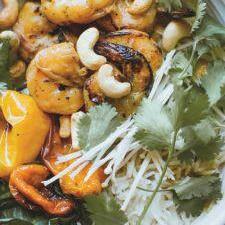







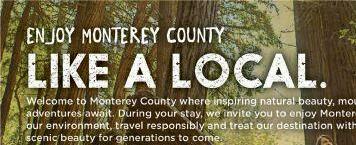






GRIST FOR THE MILL 6 EDIBLE NOTABLES
A Scotts Valley DIYer discovers the secret to the perfect cocktail, saving the Monterey Bay’s endangered fishermen, living the craft beer life, recovery through cooking, craft butchery and Mangalitsa pigs coming to Seaside.
20 WHAT’S IN SEASON CARROTS
is vibrant year-round staple tastes best in winter when its sugar content is highest
27 FOODSHED WINTER FARMERS’ MARKETS
A complete guide to the Monterey Bay area


30 BEHIND THE BOTTLE POP STARS
Local winemakers get out in front of the sparkling wine boom with lots of pink and a rainbow of quirky new bubbly varieties
36 ON THE FARM GOING ORGANIC
Decades after the Monterey Bay area established itself at the vanguard of the organic movement, consumer demand is spreading organic growing practices throughout the region
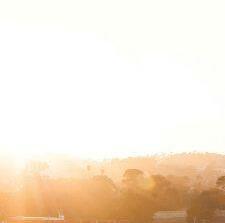
Sidebar: A new film, Evolution of Organic, explores the history and future of the organic movement





44 BACK OF THE HOUSE WOMEN IN THE KITCHEN
Women chefs are well represented in the Monterey Bay area and we talk with three of them about how they’ve achieved success in what has traditionally been a man’s world
48 THE PRESERVATIONIST YOGURT AND KEFIR
Learn how to make nutritious and delicious cultured milk products in your own kitchen 53 DINE LOCAL GUIDE 65 LOCAL SOURCE GUIDE 68 LAST
CALL MUSHROOMS
An illustrated guide, just in time for the winter rains that spawn them
COVER PHOTOGRAPH e secret to a perfect cocktail by Michelle Magdalena
CONTENTS PHOTOGRAPH Monterey harbor by Michelle Magdalena


2 edible MONTEREY BAY WINTER 2017 4
Contents












GRIST FOR THE MILL
MONTEREY BAY
PUBLISHER AND EDITOR

Sarah Wood Sarah@ediblemontereybay.com 831.298.7117 or 831.238.1217
CO–PUBLISHER AND ASSOCIATE EDITOR Rob Fisher
DEPUTY AND DIGITAL EDITOR Deborah Luhrman
COPY EDITOR Doresa Banning
LAYOUT DESIGN Melissa Petersen
Do you want more? Perhaps more time in your day, more appreciation for what you do, more financial resources for making your dreams come true?
If you read this letter regularly, you’re probably expecting us to urge caution here. We might suggest that before you risk slipping down the spiritual and existential slope that leads to a trap of insatiable, unstoppable striving, you first consider what is actually enough, and whether you’re being fully present to the riches already surrounding you. And there would be wisdom in that!
But if the “more” that you’re hungering for today is more Edible Monterey Bay, we’re going to take this opportunity to shamelessly—and sincerely—agree with you. We absolutely believe you deserve more of the goodness in these pages, and we’d like to provide it to you!
For example, did you know that late every Tuesday afternoon, EMB deputy editor Deborah Luhrman sends out a stellar e-newsletter filled with exclusive local food news and comprehensive local food event previews—as well as updates from the national good food movement?
What’s more, our newsletter has about double the so-called click-and-open rates of typical media newsletters—meaning that our readers are about twice as excited about receiving it as readers of the average newsletter are about getting theirs! We’d love to send it to you, so if you haven’t already, please put down this magazine now and go register for the newsletter at www.ediblemontereybay.com. It’s free!
And if it’s more of these print pages that you crave, there is a solution for that as well! As any of our wonderful contributors will tell you, at press time, we sadly always have more fantastic stories than we can fit in the magazine. But like any publication, we can only afford to print a certain ratio of editorial pages for every page of advertisements we receive, so our magazine size is limited by our advertising support.
And that’s where you come in. If you own or work for a local business, please consider how advertising would benefit us both. Send your questions to ads@ediblemontereybay.com. And if you become an advertising partner, you’ll find you get a different kind of more—more opportunities to collaborate on events with us and benefit from other value-added marketing opportunities. And more importantly, you’ll see more business from the folks who read your ads in EMB.
One final way to receive more Edible is simply to buy a subscription for home delivery—for yourself or someone else who might want a little more, too. Just go back to www.ediblemontereybay and click on the “Subscribe” tab.
Meantime, we hope reading the pages of this magazine will give you more joy and more interesting topics to think about than you ever imagined.
Best wishes for a happy and healthy holiday season and a terrific new year,
Wood and Rob Fisher Publishers
EDITORIAL ASSISTANT AND EVENTS MANAGER Rosie Parker
AD DESIGNERS Dina Clark • Bigfish
Smallpond Design • Jane Bolling Design
Zephyr Pfotenhauer • Marilet Pretorius Melissa oeny Designs
CONTRIBUTORS Crystal Birns
Jordan Champagne • Jamie Collins
Bambi Edlund • Zoe Fisher • Margaux Gibbons
Lynsie Larkin • Elizabeth Limbach
Michelle Magdalena • Camilla M. Mann
Kathryn McKenzie • Rosie Parker
Derrick Peterman • Zephyr Pfotenhauer
Lily Stoicheff • Patrick Tregenza Amber Turpin • Patrice Vecchione
ADVERTISING SALES

ads@ediblemontereybay.com • 831.238.1217
Shelby Lambert shelby@ediblemontereybay.com Kate Robbins kate@ediblemontereybay.com Sarah Wood sarah@ediblemontereybay.com
DISTRIBUTIONMANAGER Mick Freeman
CONTACT US:

Edible Monterey Bay P.O. Box 228, Carmel Valley, CA 93924 www.ediblemontereybay.com 831.298.7117 or 831.238.1217 info@ediblemontereybay.com
Edible Monterey Bay is published quarterly. All rights reserved. No part of this publication may be used without written permission of the publisher. Subscriptions are $28 per year at www.ediblemontereybay.com. Every effort is made to avoid errors, misspellings and omissions. If, however, an error comes to your attention, please accept our apologies and notify us. We also welcome letters to the above address. ank you.
4 edible MONTEREY BAYWINTER 2017
Sarah
edible
Photo by Zoe Fisher



















6 edible MONTEREY BAYWINTER 2017
EDIBLE NOTABLES PURE ICE


 BY LILY STOICHEFF PHOTOGRAPHY BY MICHELLE MAGDALENA
BY LILY STOICHEFF PHOTOGRAPHY BY MICHELLE MAGDALENA
e key to a truly stellar cocktail may go beyond top-shelf liquors and trendy mixing techniques. In fact, the secret ingredient may be something that is odorless, colorless and tasteless, and easily made at home—ice.
Not just any ice, says Mark Davidson, a software-engineer-by-day, cocktail-enthusiast-by-night. “e secret sauce is pure ice. It makes a clear, clean cocktail.”

If you thought the ice in your freezer was already pure, take a closer look. Little cracks and bubbles on the inside of the cube are evidence of trapped impurities like chlorine, organic compounds and suspended particles which result in opaque, muddy streaks. Not only are they visually unappealing, but these traditional ice cubes melt quickly, diluting a high-quality cocktail with low-quality water.
Driven by a desire to create a perfect gin and tonic, Davidson, a former scientist, had already delved deep into the world of home cocktail-making when a book, Liquid Intelligence: e Art and Science of the Perfect Cocktail, pushed him further down the rabbit hole with a recipe for ice.

e process removes the impurities and gases that are found in water and freezes it by methods that render the result perfectly clear.
e ultimate presentation is dramatic, especially when using premium tonic and gin, Davidson says. “If I get it right, it looks like a clear glass of water with a lime, and you can’t see the ice cube.”
To create pure ice at his home in Scotts Valley, Davidson boils a gallon or two of tap water twice to remove chlorine and other basic impurities before pouring the water into an insulated cooler. After the water cools to room temperature, he freezes the water in the cooler, lid open, for 36 to 48 hours.


In a traditional ice cube tray, which is not insulated in any way, cold air hits the water from all sides, which pushes impurities towards the center of the cube. As the ice freezes and expands, mini-explosions shatter the center of the cube, creating the telltale white center. e pure ice method uses directional freezing, with cold air cooling the water from one direction. As the water freezes from the top down, its natural crystalline structure builds piece by piece while pushing impu-


How one man’s quest to mix the perfect drink led him to his freezer—and how you can recreate what he discovered at home
www.ediblemontereybay.com 7
rities to the bottom of the cooler. Davidson, who grew up in Michigan, explains that this is similar to how lake water freezes.

Once frozen, Davidson lets the outside of the ice come to room temperature for about 30 minutes (the surface almost sweaty and no longer frosty) before sliding the block out of the cooler. With the exception of a couple inches of frosty-looking impure ice at the bottom, the ice is beautifully clear.
e last step—cutting the block into cubes that will fit in your glass—is arguably the hardest. After tempering the block, Davidson scores it with a knife and, using a cleaver and a plastic mallet, shears away slices and divides them into 2-inch cubes—with varying success. “Strange shapes are good enough. e effect, aesthetically, is still amazing,” he says. e important thing is to avoid small cubes and try instead for large blocks, which melt much more slowly. “ey can last 30 to 40 minutes without excessive dilution and the flavor profile doesn’t change dramatically.”

e cubes can be kept in the freezer on a tray covered with a lid. But before using them in a cocktail, Davidson advises taking them out



of the freezer and letting them sit in a bowl for 20 to 30 minutes; if their surface has not first reached room temperature, the cubes may crack when you pour other ingredients over them.

Davidson acknowledges with a laugh that the process may seem lengthy. “But all you really need is space, a little patience and materials at hand,” he says, “and the results are worth it.”

Lily Stoicheff is an eater and writer living in Santa Cruz with a soft spot for points of historical interest and a passion for pickles that threatens to take over her fridge.
RECIPE: For Mark Davidson’s Perfect Gin and Tonic, see opposite.

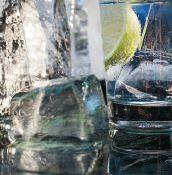







8 edible MONTEREY BAYWINTER 2017
MARK DAVIDSON’S PERFECT GIN AND TONIC












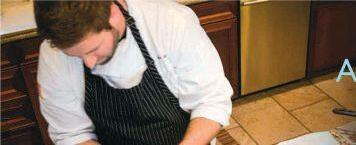


1¾ ounces gin (Venus Gin No. 01 or Bombay Sapphire)



3¼ ounces Fever-Tree Tonic Water 1 2-inch block pure ice, tempered 20–30 minutes Wedge of lime


To achieve the “glass of water” effect of a nearly perfectly clear drink, take care throughout to not agitate the ingredients. Add gin to glass. Tilt glass and pour tonic gently so as not to agitate. Gently squeeze a few drops of juice from a wedge of lime into the glass. Carefully place a large, 2-inch ice block in the glass. Drop lime wedge on top of ice block. Do not stir. Drink and enjoy!

www.ediblemontereybay.com 9
EDIBLE NOTABLES FISHING FOR A COMEBACK





Can a new “fish hub” revive the Monterey Bay fishing industry?






 BY ELIZABETH LIMBACH
BY ELIZABETH LIMBACH

ird-generation Monterey fisherman John Pennisi is preparing to relaunch his boat, e Irene’s Way, after eight years of keeping it docked. “It’s almost like starting all over again,” he says.


Pennisi’s return to fishing Monterey’s waters, hopefully by early 2018, is part of a wider comeback for the Monterey Bay fishing industry that is being nurtured by the Monterey Bay Fisheries Trust.
In partnership with the City of Monterey and the Monterey Bay Aquarium, the nonprofit has spent the last year developing plans for a “fish hub” designed to jumpstart Monterey Bay’s struggling fishing business—with an initial focus on Monterey harbor, and an eventual goal of spreading the benefits to Moss Landing and Santa Cruz. To be successful, the hub will need to address both the proverbial chicken and the egg, simultaneously boosting both the supply of and demand for fish harvested from our local waters.
e idea is modeled after “food hubs,” hundreds of which have cropped up across the country in recent years. “A food hub can range anywhere from somebody on a telephone connecting producers with buyers to a full-scale building with refrigeration, processing, trucks,

“fish







10 edible MONTEREY BAYWINTER 2017
Reviving an industry: Monterey Bay Fisheries Trust executive director Sherry Flumerfelt, above left hopes a new
hub” will help create the increased demand for local fish that fishermen like John Pennisi, above right, need for their fishing businesses to thrive.
distribution, ice and a retail space,” says the trust’s executive director, Sherry Flumerfelt.

Fish hubs are a newer concept but the intentions are similar. Following a feasibility study finished in June, the trust decided that the fish hub’s first step, by early 2018, will be to hire a full-time valuechain coordinator whose priority will be to rebuild connections between fishermen and buyers.
Stories like Pennisi’s sparked the initial idea for the project, and feedback from him and others has shaped it along the way.

Growing up, Pennisi couldn’t wait for school to get out so he could race down to the docks and climb aboard his family’s fishing boat. He and his brothers, including well-known fisherman Giuseppe “Joe” Pennisi, never doubted that they’d become fishermen, too.
“We were so proud to be able to follow in the footsteps of my grandfather and my father,” says the 54 year old. Years later, Pennisi’s own sons aspired to carry on the family tradition. But by the time they came of age, it was a floundering business. “ey were right behind me up until the disaster hit,” Pennisi says.

e Pennisis are groundfish trawlers, fishing for about 60 different bottom-dwelling species including halibut, sole, sanddabs and rockfish. For decades, this provided them with a happy and stable life: Pennisi’s parents owned a popular fish store, Royal Seafood Market, at the wharf in Monterey for 50 years, as well as a fish freezer plant. Between its members, the family owned six groundfish trawlers. But the life they’d known became endangered around the new millennium, when trouble struck the West Coast groundfish fishery—one of the most significant fisheries in the Monterey Bay.
“It was poorly managed and, over time, fish stocks started to become depleted and fishing businesses started to shut down,” says Flumerfelt. e federal government declared the fishery a disaster in 2000, and nine groundfish stocks were deemed overfished. e Monterey Bay Aquarium’s Seafood Watch program placed many of the groundfish species on its “Avoid” list. e loss of the groundfish fishery was particularly painful, as it had provided local fishermen with a bountiful source of year-round income, unlike seasonal fisheries, like those for Dungeness crab and salmon. Eventually, the fleet of local boats fishing out of Monterey Bay—once numbering in the hundreds—dwindled to a fraction of its size.
e Pennisis were one of the fishing families hit by the downturn, and they lost their store, freezer plant, three trawlers and, worst of all, their identity. “If somebody asked me what I am, I wouldn’t tell them I’m Italian and Irish,” says Pennisi. “I’d tell them I’m a fisherman. It’s what we are. It’s my first thought of myself: ‘We’re fishermen.’ at got taken away; who we are got taken away.”
As local fishing diminished, suppliers of cheap imported seafood stepped in, and local markets and restaurants started offering mostly fish from other regions and abroad. As a result, buyers solidified relationships with those distributors, and customers lost their appetites for many types of local seafood like petrale sole or black cod. “ey don’t know what it tastes like to eat rockfish—its more exotic to them than eating tilapia from China, even though it’s from our backyard,” says Flumerfelt.

But over time, the groundfish fishery experienced a remarkable recovery. anks to cooperation between regulators, fishermen and en-

www.ediblemontereybay.com 11
vironmental groups, by 2014 it had bounced back to such an impressive degree that the Marine Stewardship Council certified the fishery as sustainable, and Seafood Watch upgraded 21 species of groundfish from ones to “Avoid” to a “Best Choice” or “Good Alternative.” And thanks to an initiative by the Monterey Bay Fisheries Trust, valuable government-established fishing quotas were purchased and held in trust to be leased back to local fishermen, ensuring that they could afford to compete with outside interests for rights to harvest local fish.


Still, the recovery has come at a cost. Monterey Bay fishermen now navigate a steep set of regulations and requirements, such as paying to have a federal observer aboard on each outing. “Local fishermen are arguably the most highly regulated industry in the world,” says Flumerfelt, and that adds to their expense of doing business.
Moreover, now that they’re ready to deliver sustainable fish to the docks, there are fewer buyers waiting for them, and there is no longer the kind of infrastructure (such as filleters and commercial ice makers) needed to get the fish from boat to buyer. So, as it stands, explains Flumerfelt, “e local fishermen will land their fish and it will get taken out of town, merged in with fish from all over the place [so that] it’s no longer ‘sustainable petrale sole from Monterey Bay’—it’s just some white fish.”
“ese fishermen are fishing sustainably and responsibly and making great investments in doing so, but not necessarily being rewarded in the marketplace,” she adds.
e initial version of the fish hub will focus on tackling these issues. Once the value-chain coordinator position is filled, that person will work on establishing relationships along the supply chain. “If there is demand, then fishermen will start getting up and running again, and you’ll be able to afford an ice machine, and you’ll be able to get a processor, and everything will start to fall into place again,” says Flumerfelt.

In the meantime, the trust is working on a traceability program that will make it possible for Monterey Bay-caught seafood to keep its identity from boat to plate. e nascent fish hub will evolve as it gains steam—perhaps, someday, even involving a full-scale facility. (“Wouldn’t that be great? But we’re not there yet,” says Flumerfelt.)

For Pennisi, the project provides hope that he can be proud, once again, to be a Monterey fisherman. “I see a light at the end of the tunnel, whereas before I didn’t,” he says. “I hope it’s going to bring back what started this town: the fishing industry.”

12 edible MONTEREY BAYWINTER 2017
Elizabeth Limbach is a freelance journalist living in Santa Cruz, where she writes about culture, the food system and the environment.
EDIBLE NOTABLES BREWERY TWENTY FIVE

A passion for great beer has guided this couple up the long and eventful road to opening a new taproom in San Juan Bautista
BY DERRICK PETERMAN PHOTOGRAPHY BY LYNSIE LARKIN AND MICHELLE MAGDALENA

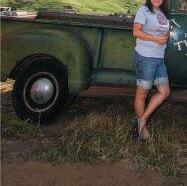
Brewery Twenty Five, just outside of San Juan Bautista, is a little hard to find. It sits on top of a steep hill behind the house of brewery owners Fran and Sean Fitzharris. is rugged spot is not the most ideal place for a brewery.

“It’s a fun story now, but we lost a keg rolling down the hill,” Fran says. “It just broke my heart at the time.” en there’s the challenge of getting equipment into the brewery. “Getting these two fermenters up the hill was an adventure in itself,” says Sean, recalling the day that two 200-gallon stainless steel tanks were slowly eased up the narrow, winding road to the top. Delivery trucks carrying malted grain can’t negotiate the route at all, so they are forced to wait at the foot of the hill for one of the Fitzharrises to drive down and transfer the merchandise to their pickup truck.
But despite these challenges, Brewery Twenty Five has grown gradually since the couple started it four years ago, and the Fitzharrises are set to open their own taproom in downtown San Juan Bautista before the end of the year. e taproom will be the latest step in a 16-year beer journey for the couple—and the trip is gathering momentum.
In 2001, Sean had been working as a computer programmer for various startups in the San Jose area and brewing beer was nowhere on his radar screen.

“I wasn’t drinking very good beer at the time,” Sean says of those days. en he met Fran, a craft beer enthusiast who collects growlers signed by legendary brewers the way sports fans collect autographed jerseys. Together, they began to explore craft beer. “A lot of our dates and trips revolved around going someplace for beer, and whenever we would travel, we’d ask ourselves what breweries would be along the way,” Sean says. ey ex-
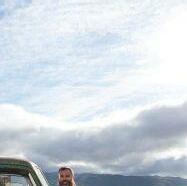
www.ediblemontereybay.com 13
Fran and Sean Fitzharris at their brewery
Photo by Lynsie Larkin
plored breweries up and down the West Coast, making new friends and absorbing the emerging beer culture at each stop.
Sean started home brewing, beginning with simple beers before graduating to more complex concoctions. “I love cooking, I grew up cooking with my dad and grandmother and brewing is really cooking,” Sean says. ey also got to know many brewery owners in nearby Santa Cruz and wondered if maybe they should go into the beer business themselves.
e Fitzharrises spent another three years doing research and slowly amassing equipment before opening their production brewery in January of 2015, naming it after the state highway running north-south through San Benito County. Sean is the brewer, working evenings and weekends as he continues to work as a programmer, while Fran handles the business’s day-to-day operations full time.
ousands of homebrewers and craft beer enthusiasts have opened breweries all over the United States. But in this age of ready-made brewing equipment and crowdfunding, Brewery Twenty Five is a throwback to the earliest days of craft beer, when people like Sierra Nevada Brewing’s Ken Grossman used their own money to patch together breweries from discarded junk and used dairy equipment. e Fitzharrises’ seven-barrel brewing system (one beer barrel = 31 gallons) employs an old dairy tank found on Craigslist and a system of copper pipes with holes and slits added to extract fermentable sugars from the malted grain using hot water. Elsewhere in their brewing process, the Fitzharrises have plugged in used equipment purchased from nearby breweries. In the middle of everything are two large, shiny fermentation tanks named elma and Louise after the Fitzharrises’ two large Australian shepherds, who have passed away but continue to live in spirit within the brewery.
en there was the time they found a walk-in refrigerator, normally costing $3,000–$4,000, on sale at a closed Morgan Hill mushroom farm for only $300. “When I read the ad, I thought it was a misprint,” Fran says. Visiting the farm, they were relieved to discover the price was no mistake. e bad news: ey had to remove the large walk-in from the seller’s property that very day. “So we figured out how to take it apart, get it in


the truck, and then got it up the hill and put it back together here,” explains Sean.
As for the beer, Brewery Twenty Five often infuses the flavors of the local community into its brews. Its Fuzzy Jules Apricot Wheat beer, named after a local second grade teacher, uses apricots sourced from Hollister’s B&R Farms. Normally brewed in the sum-
very tart fruit,” says Sean, who adds it to a neutral wheat-based beer, allowing its tangy flavor to really shine. “A lot of folks really into sours love this beer,” Fran says.
Of course, any California brewery is virtually required to have an IPA. But Brewery Twenty Five’s Oatie Oats IPA, which utilizes flaked oats to add a creamy mouthfeel, and mosaic and Citra hops to contribute tropical and citrus flavors, is much more restrained and balanced than most West Coast IPAs. “It’s a very approachable IPA that’s more about the flavor and aroma than bitterness,” explains Sean.
All of this will be found in Brewery Twenty Five’s new taproom. e main room will feature a bar and will be decorated with local art, antiques and other objects. In the back, the Fitzharrises are planning a room that will chronicle their explorations of craft beer culture with pictures of Sean and Fran on their various travels, as well as Fran’s collection of autographed growlers and tap handles. Reflecting on her initial discovery of craft beer, Fran says, “I was super lucky back in the ’90s. I was around people who knew about good beer. I was that person telling everyone the stories about people like Ken Grossman.”
Now, with the opening of their San Juan Bautista taproom, Sean and Fran finally get to tell their piece of that story.
mer months, the light tartness from the apricots works well with underlying wheat beer to create a fresh, vibrant brew. For its Many Moons Stout, Brewery Twenty Five adds beans from San Juan Bautista’s cult coffeehouse, Vertigo Coffee Roasters, along with cocoa nibs and vanilla beans to create a highly complex, rich stout. A long-term project in the works is a sour wheat ale aged in chardonnay barrels from Hollister’s Leal Vineyards. Sometimes Sean ventures well beyond San Benito County for his inspirations, like when he added lemongrass and ai spices to his stout. Other times, he’ll add toasted coconut. en there’s his Passion Fruit Wheat. “Passion fruit is an interesting beast—it’s a
Derrick Peterman came to Northern California nearly 20 years ago, chasing a dream in technology, and discovered all the region’s great breweries along the way. He writes mostly about beer and sometimes about running, at the blog Ramblings of a Beer Runner (ramblings-of-a-beer-runner.blog).
Brewery Twenty Five 106 3rd St., San Juan Bautista 831.636.7640 www.BreweryTwentyFive.com

14 edible MONTEREY BAYWINTER 2017
Photo by Michelle Magdalena
Brewery Twenty Five will soon open its taproom in San Juan Bautista.


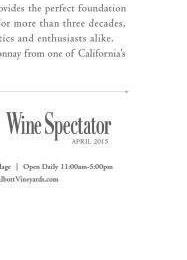


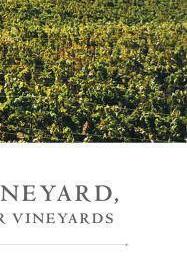






EDIBLE NOTABLES RECIPE FOR RECOVERY




Bridge Culinary helps former addicts cook up new job opportunities —and offers the community catering for a cause
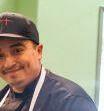


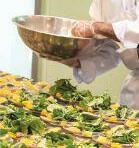


 BY ROSIE PARKER • PHOTOGRAPHY BY MARGAUX GIBBONS
BY ROSIE PARKER • PHOTOGRAPHY BY MARGAUX GIBBONS
16 edible MONTEREY BAYWINTER 2017
Clockwise from upper left, resident kitchen lead Ryan Salazar and fellow resident Benjamin Garcia; a salad of baby spinach, arugula, roasted golden beats, orange candied walnuts, goat cheese and pickled red onions prepared by the residents; and a group shot of all the cooks the night of their annual fundraiser, from left, Jesse Diaz, Ryan Salazar, Benjamin Garcia, Cache Swanson, chef Zach Wilson, Larry Callahan, Lamont Dunlap, Matt Turner, Rudy Divin, James Harriss, Efren Celaya, Frank Rebelo and Fortino Lario.
“We’re trying to make something out of nothing here,” Zach Wilson says emphatically on the morning of e Bridge Restoration Ministry’s 11th annual fundraising banquet in October. Wilson is the chef/educator behind Bridge Culinary—the new culinary training program and catering service that is part of e Bridge’s 12-month residential rehab program for men and women recovering from substance abuse. Along with his focused team of program residents, Wilson is cooking an elaborate dinner for tonight’s 300-seat, sold-out event.
Wilson started developing the program about a year ago when he was a resident at e Bridge himself. Director and founder Mike Casey says that it was always a goal to establish a culinary education program. As he puts it, “e guys always naturally gravitated towards the kitchen.” So when Wilson, who previously worked for Aqua Terra Culinary and Rancho Cielo Drummond Culinary Academy, entered rehab with the intention of utilizing his background while he was committed to the program, Casey was excited to support his efforts.
Wilson started by organizing the residents to cook weekday dinners for the house. “Some of this is just about teaching these guys how to cook for themselves—fresh, homemade meals,” Wilson explains. But for those at e Bridge who are serious about pursuing a culinary or other service industry career, he wanted to provide the correct training to give them a competitive edge in the job market after they leave the program. Eventually, Wilson aims to open a Bridge restaurant where the program participants can work.
Since it opened in 2006, e Bridge has always had a vocational training element, which in the realm of culinary skills included residents working after Sunday’s services at e Grille at Calvary Monterey, a church with which the Bridge is affiliated. But after completing the residential program, Wilson was hired by e Bridge and expanded on that. He implemented a curriculum with structured class time when residents can learn the basics of French technique along with practical skills—such as purchasing, budgeting and meal prep.
“ere’s been a lot of trial and error these past few months, but that’s what needs to happen,” says Benjamin Garcia, an affable yet determined resident. “It’s encouraging to be

able to see the growth of the program while at the same time seeing growth in myself through all the new things I’m learning in the kitchen.”
For Wilson and the residents, the most rewarding aspect of Bridge Culinary has been catering. From church socials to weddings to chamber of commerce events to a luncheon for the probation department, Bridge Culinary has built an impressive roster of clients over the past few months.
“Having all the probation officers for lunch—that was a big deal!” says Casey. “Opportunities like that give these guys confidence to be out in the community and be recognized for something other than their past.”
Moving forward is a key element to e Bridge, but Wilson also believes in complete transparency about his journey. “It’s easier to tell the truth and be upfront and honest about yourself,” Wilson tells me. “We’re a Christian program—we don’t hide in the shadows; we face our demons.” is extends to the relationship Bridge Culinary wishes to have with the community: “I want people to know that we’re here to cook tasty food, but also to connect and share our stories and potentially help people who are going through their own battles with addiction.”
“We’re here for our community, both small and large,” Wilson continues, “to connect, to train, and to put good, sober people back in the workforce.” When questioned about the challenges that exist for graduates entering an industry that is notorious for addiction, Wilson thoughtfully considers his answer. “I do recognize the challenges,” he says. “But you have to send people back into the world eventually. I’m a chef. is is what I can teach. is is how I can help.”
“Food is the backbone of our community—the growing, the cooking, the eating,” he later reflects. “We’re working hard to be a part of that.”
Rosie Parker, a native New Englander, likes to complain of missing home while living the Santa Cruz high life—surfing, hiking, writing and working for a delicious craft brewery.


Bridge Culinary e Bridge Restoration Ministry 225 Central Ave., Pacific Grove 831.521.5964 • www.bridgeculinary.org

www.ediblemontereybay.com 17
EDIBLE NOTABLES MISSING LINKS






Two popular local chefs beef up the Monterey Peninsula’s foodshed with a new artisanal butcher shop
STORY AND PHOTOGRAPHY
 BY CAMILLA M. MANN
BY CAMILLA M. MANN
Our Monterey Bay-area foodshed abounds with artisanal bakers, jam creators and even candlestick makers—but butchers, not so much. at’s why it’s so exciting to watch e Meatery taking shape in Seaside. e project of beloved local chefs Jason Balestrieri and Kevin Hincks, the new artisanal butchery at 1534 Fremont Blvd. is set to begin offering homemade sausages, custom-cut meats and deli sandwiches in a friendly, old-timey setting in early 2018.
e 2,200-square-foot space had been stripped down to the bricks when Balestrieri and Hincks walked me through in October. ey are going for a hip yet classic butcher shop feel by installing a pressed tin ceiling and using lots of white subway tile and reclaimed wood. e design includes three coolers—one for dry aging, one for curing and one for general use. ey are also putting in a large communal table, where customers can enjoy high-end sandwiches and a rotating menu of hot foods, as well as monthly pop-up dinners.
Balestrieri and Hincks met when they were both chefs at Cantinetta Luca in Carmel where Balestrieri was executive chef and partner for more than a decade. First colleagues, then friends, the chefs have embarked on opening a modern butcher shop that will connect customers to their meat. “We’re passionate about meat,” explains Hincks. “We’re good Midwestern boys, after all.” Balestrieri grew up in Wisconsin. Hincks hails from Illinois.

rough the artisanal craft of butchering and handcrafted charcuterie, they are committed to building relationships within the community and bridging the gap between producers and consumers. Balestrieri looks forward to making salumi more accessible to local con-


18 edible MONTEREY BAYWINTER 2017
ey know their farmers: Chefs Jason Balestrieri and Kevin Hincks visit the heritage Mangalitsa pigs being raised for them in Cachagua.
sumers—especially prosciutto, salami and lardo, like he created and served at Cantinetta Luca.
“In this day and age, in this community, people go to markets and are connected to the people growing their fruits and vegetables,” Balestrieri says. “We want to support that growing awareness with meat.”

To that end, e Meatery will offer customers a full-service butcher where you can pick up fresh cuts of meat; a deli with made-toorder sandwiches; a cold case packed with housemade salumi; and hot food offerings that you can take to go or eat in the retail space. e owners also plan to host cooking classes and community dinners. Additionally, they will use the kitchen for catering outside events.
“We want a higher level of community,” Hincks says, “and people deserve to know where their food comes from.” rough their collective years in local kitchens, both chefs have fostered relationships with ranchers who are producing sustainably and ethically raised animals.

One afternoon I accompanied Balestrieri and Hincks to the Keaton Family Farm in Cachagua. “Hug the shoulder of the road and stay right on our bumper,” Hincks instructed before we headed out to visit three of the Mangalitsa pigs they are raising out in Carmel Valley.
e Mangalitsas are a wooly heritage breed pig indigenous to Hungary that has battled back from the brink of extinction because their creamy lard is prized by chefs and diners alike. e Slow Food Movement lists Mangalitsas in its Ark of Taste, a catalog of endangered heritage foods that are sustainably produced, distinct in flavor and uniquely relevant to the food chain. e Ark of Taste actively promotes conservation through cultivation for consumption by identifying breeds that are worth saving—and worth eating.
Balestrieri explains the uniqueness of the Mangalitsa lard, “It melts at a lower temperature than other pigs’ lard because it contains more unsaturated fat.” He admits it’s not well-suited for use in charcuterie. “I tried to use it in salami once and it didn’t turn out well. It was too soft.” But he knows the luscious fat with titanic thickness is well-suited for lardo, a traditional Italian cured pork fat, and plans to make that as soon as the pigs are fully grown.
ese days, many people demand the meat they buy be raised free range and humanely outdoors. e Mangalitsas are raised under those kinds of ideal conditions, but the chefs will also offer meats that are less expensive to produce. “I won’t go as far as saying it will be all grassfed, all organic,” Hincks admits, noting that would be price prohibitive, but e Meatery is committed to sourcing ethically and sustainably raised animals and will offer grass-fed, organic and local meats when available.
At the Seaside City Council meeting for their building permit, the partners were asked if they would carry rabbits, goats and other specialty meats. Balestrieri answered that that is their intention. “We want people on the Peninsula who have been driving north to go to el Salchichero, Freedom Meat Lockers and Corralitos Market & Sausage Co. to find what they want at e Meatery.”
Two Seaside residents hearing about the project expressed delight. “I will definitely start getting my meats there,” gushes Undine Lauer who grew up on a ranch in Oregon. “We don’t have anything like this.”
Jennifer Fletcher agrees she’s looking forward to having a reliable, reputable butcher in the neighborhood. Having lived overseas, she re-
calls visiting butcher shops in London. “It demystifies the process and, I think, will encourage more adventurous eating since people can ask the butchers, ‘How do I prepare that?’”
Hincks says, “With enough lead time, we’ll be able to get whatever our customers want.” While they will be focused on meat, he says that because they are breaking down the whole animals, they’ll be able to offer everything from bones and offal to bone broth and dog treats.
Because they are designing e Meatery to connect consumers to the meat, their entire process embraces transparency. Large glass windows will offer a behind-the-scenes view of the shop where you can see the butchers at work.
For this new venture together, the partners are thrilled to be in Seaside, where artisanal businesses such as Acme Coffee have a foothold and the new Other Brother Beer Co. is set to open in 2018. “I think Seaside is trying to reinvigorate itself and I’m happy to be a part of that growth,” Balestrieri says.
Camilla M. Mann is a food writer, photographer, adventurer and passionate cook. She blogs at www.culinary-adventures-with-cam.blogspot.com and lives in Seaside.
e Meatery
1534 Fremont Blvd., Seaside 831.915.7408 • www.themeatery.us

www.ediblemontereybay.com 19












20 edible MONTEREY BAYWINTER 2017
WHAT’S IN SEASON CARROTS
BY JAMIE COLLINS
Did you know that although carrots can be grown practically year-round in the Monterey Bay area, they are the tastiest when harvested and eaten in winter? is is because carrots, like parsnips, convert their starches to sugars when it turns cold, an adaptation that protects their cells from freezing when the temperature drops—and makes them an especially flavorful as well as beautiful seasonal vegetable for your winter menus.
COLORFUL HISTORY
Wild carrots evolved in many different colors and the ubiquitous orange color only appeared a few hundred years ago, apparently after seed breeders decided that orange carrots had the best flavor. If you talk to Ronald Donkervoort, who owns Windmill Farm in Moss Landing and sells his beautiful carrots at the local Santa Cruz farmers’ markets, he will tell you a different version of the story common in his native Netherlands—that the orange color was developed by Dutch breeders as a tribute to William of Orange, who led the movement for independence from Spain. Sources such as the World Carrot Museum, an online compendium of lore about carrots (www.carrotmuseum.co.uk) say historians haven’t proved this and the tale may be apocryphal, but still it persists, and it’s an interesting story, befitting its colorful subject!
ied colors of carrots are the norm because those countries never selected just orange. Seed banks and breeders in the United States now collaborate with their counterparts in these countries, hoping to bring back original carrot strains to be bred in the U.S.
NUTRITION AND FLAVOR
One would have to live under a rock to have not heard that carrots are great for your vision, thanks to their beta-carotene. But they also reduce cholesterol and lower blood pressure due to being rich in potassium, a vasodilator that increases blood flow and circulation. Carrots also have antibacterial properties which boost the immune system, and vitamin C which stimulates the activity of white blood cells. Carrots have tons of fiber, which aids digestion and helps prevent cancer—notably lung, breast and colon.
for the home gardener to grow. A few of the best varieties are Nelson, Mokum and Yaya, which are quick to grow to a harvestable size.
Chantennay are shorter than others but have wider shoulders and are tapered with large foliage, which makes them best for mechanical harvesting. ey store well, and are mostly used for processing into juice or “baby” carrots (which are actually not baby carrots at all but pieces of larger carrots that are rolled by machinery to create a small carrot). ese come in red and orange varieties.
ParisMarkettype, aka umbelina or Tonda di Parigi, are round and stumpy, specialty orange carrots that are tasty whole next to roasted chicken and slow-roasted stews. ey are great to plant if you have shallow soils as they only grow about 2 inches in length.
Kuroda carrots have good yields, are tender and sweet and make an excellent juicing carrot. Of all the tasty varieties of carrots, my all-time favorite to grow was a fat, dark-yellow kuroda called Kinbi, but I have been unable to find the seed for several years. When cooked, the Kinbi tasted a lot like sweet potato, probably due to higher starch content. I keep trying different yellow varieties but all pale in comparison to the Kinbi.
Lucky for market goers, carrots of all colors of the rainbow are widely available again today. ey are being bred to be the deepest and darkest of the red, orange and purple carrot color spectrum to increase their healthful components such as anthocyanins (contained in purple varieties) and beta-carotene (red and orange varieties). If you were to visit India, the Middle East or Japan, you would find var-
e flavors of carrots mostly come from volatile oils called terpenoids—these can be floral, spicy, citrusy, pine like and more. If the terpenoids are too strong, the flavor will be harsh. erefore a nice balance of this compound paired with a high sugar content is what makes a carrot tasty. Imagine how many carrot flavors there are in the world. What fun it would be to try them all and what amazing dishes they would make if selected for their individual terpenoids!
CARROT VARIETIES
Nantes carrots are thin, sweet and 6–7 inches long with blunt tips that are good for breaking through heavy clay soils and rocky ground when other carrots fork and twist. ey are less likely to get woody cores when left in the fields. Nantes are favored by chefs and easiest
GROWING CARROTS
Carrots are some of the most rewarding vegetables to grow in the garden. Because they are directly seeded and like a sandy, loamy soil without rocks or hardpan, be sure to loosen the soil well before planting. In the soil make a shallow ¼-inch line with a pencil and plant by rolling the seed between your thumb and pointer finger while moving along the line, trying to plant about 30 seeds per foot. Space Photo this page, 24 and 25, courtesy Ventana Big Sur
www.ediblemontereybay.com 21
is vibrant year-round staple tastes best in winter when its sugar content is highest
the lines at least 6 inches apart, or up to 18 inches in a farm row for ease of cultivation with a tractor. Gently cover the seeds, being careful not to place more soil than necessary. Keep the seeds moist until they emerge. e closer the carrots are planted, the more slender they will be. If they are too close, they will need to be thinned out or there will not be space for a carrot to grow into one worth eating. Depending on the variety, carrots are ready to harvest in anywhere from 65–80 days. As carrot seeds age, their germination rate goes down dramatically so be sure to buy only enough seed for one season.
It is best to plant carrots only once every three years in the same location. is keeps disease pressure at a minimum and reduces nematode (tiny worms that eat the carrot) pressure and improves soil health. Since carrots are in the Apiaceae family just like dill, parsley, celery, fennel and parsnips, it is also best to not follow carrots with any other Apiaceae crop.
Onions, radishes and aromatic herbs like rosemary and sage are good companion plants for carrots as they deter pests. Tomatoes are a great vegetable to grow between carrot crops because they contain a natural insect deterrent called solanine, which kills insects that harm carrots. Carrots are also beneficial to tomatoes because the loosened soil allows more air and water to get to the roots of the tomato plant. ey will need to be planted far enough apart however or the tomato will block the sun and stunt the carrots’ growth. Beans and peas are great to interplant with carrots because they add nitrogen to the soil.
SELECTING CARROTS

Choose carrots that are firm with fresh tops that are not wilted. Once you get them home, it is best to remove the tops and store them covered in the refrigerator. Oftentimes I store them in cold water in the fridge if I am going to use them within a day or two; this keeps them extra crisp and flavorful.
CARROT GROWING Q & A

Why would a carrot be woody, bitter and tasteless instead of sweet and tender?


ese problems are due to environmental conditions while the carrot is maturing. A woody center can also mean the carrot plant was going to seed, perhaps because it was past its prime or was forced into flowering by extreme temperatures or light changes, causing it to try to procreate before dying. Carrots grow best when temperatures are between 40° and 80° F.
My carrots have swollen roots and galls on them. What would cause that?
Swollen areas on a carrot are caused by root knot nematodes, microscopic worms that restrict the nutrient uptake from the roots, causing a stunted plant. ey live in the soil and can survive on many kinds of crops. Planting marigold flowers very closely for at least three months can help rid the soil of nematodes.
What if my carrots are forked?
Forked carrots occur when damage happens to the tip of a young carrot either by soil insects or various types of nematodes that eat the tip of the carrot, causing it to branch in different directions. e carrot should still be edible even if it doesn’t look normal.
What does it mean if there are round, dark holes in my carrot?
Holes in the carrot are usually from wire worm damage. ey cause necrosis of the carrot tissue and look unappetizing. is happens when worms come up to the part of the soil that is moist, instead of staying lower down. It could mean there was a lot of rain, or the carrots were overwatered.
Why do my carrots have a bunch of baby root hairs coming off them?
Your carrots were not watered enough! Little roots coming off the main one always mean feeder roots were searching for water.
22 edible MONTEREY BAY WINTER 2017
LOCAL FOODS IN SEASON
December, January and February

Fruits: Apples • Asian Pears • Avocados • Grapefruits • Grapes • Guavas • Kiwis Kumquats • Lemons • Limes • Mandarins • Oranges • Parsnips • Pears • Persimmons Pomegranates* • Pomelos
Vegetables: Artichokes* • Arugula • Asparagus** • Beets • Bok Choy • Broccoli • Broccoli Raab • Brussels Sprouts • Burdock • Cabbage • Cardoons • Carrots • Cauliflower • Celeriac Celery • Chard • Chicory • Collards • Cress • Dandelion • Endive • Fava Greens • Fennel Garlic • Horseradish • Kale • Kohlrabi • Leeks • Mushrooms • Mustard Greens • Nettles Onions • Orach • Parsnips • Potatoes • Radishes • Rutabagas • Salsify* • Shallots • Spinach Sprouts • Winter Squash • Sunchokes • Sweet Potatoes • Turnips

Fish: Abalone • Anchovies • Cazebon • Crab, Dungeness • Crab, Rock • Flounder, Starry Grenadier, Pacific • Herring • Lingcod • Rock Cod, aka Rockfish • Sablefish, aka Black Cod • Sanddabs, Pacific • Sole, Dover, Petrale and Rex • Spot Prawns * December only ** February only
All fish listed are rated “Best Choice” or “Good Alternative” by the Monterey Bay Aquarium’s Seafood Watch program. See www.montereybayaquarium.org/cr/seafoodwatch.aspx for more information. Research assistance from RealGoodFish and SerendipityFarms
MY FAVORITE WAYS TO PREPARE CARROTS
Carrot Ginger Soup: Simply peel 5 pounds of large carrots and cut in big chunks. Boil them in 1½ gallons of water until you can poke a knife into them. Blend cooked carrots in a blender or in the pot using an immersion blender. Add 1 quart of homemade chicken or vegetable stock or 2 quarts of store bought. Peel and finely slice fresh ginger—about three or four knuckles’ worth—and add to pot. Roast garlic cloves and blend in, along with 2 sweet onions and salt, to taste. Cook on medium for an hour or until flavors meld.
Roasted Baby Carrots and their tops: Baby carrots (real immature carrots, not the industrially tumbled kind) are great tossed with olive oil and salt and cooked on a baking sheet at 375 F° until roasted. Be sure to leave the last 2 inches of carrot tops on as they are crunchy and delicious when cooked.
Carrot Jalapeño Slaw: Grate carrots with finely sliced red cabbage. Add tiny pieces of jalapeño and cilantro and make a dressing of plain yogurt, lime juice and salt. Top with
an avocado if you have it. Great on its own or added to sandwiches.
Carrot Spread: Combine roasted carrots, tahini, fresh garlic, lemon juice, cumin, cayenne and salt in a blender. Use with flatbread or even on some pasta!
Jamie Collins is owner of Serendipity Farms, which grows organic row crops in Santa Cruz and Monterey counties and distributes them through a CSA, U-picks and farmers’ markets and a virtual farm stand which can be found on Serendipity’s Facebook page.
RECIPES: For Sur House executive chef Paul Corsentino’s Roasted Baby Carrots with Carrot Purée, Forbidden Coconut Rice, Honey Cashews and Cilantro, see p. 25; for his Shaved Carrot and Fennel Salad with Poached Shrimp, Mizuna and Citrus with a Carrot Vinaigrette and his Maple and Carrot Panna Cotta with Candied Almonds, see www.ediblemontereybay.com/recipes.


www.ediblemontereybay.com 23
For the relaunch of the newly renamed and reconceived Sur House at Ventana Big Sur, executive chef Paul Corsentino has created an all-new menu inspired by the bounty of stellar sustainable ingredients available on the Central Coast. He has also planted an on-site organic garden where he intends to grow about 10% of the produce used by his kitchen. A multitude of carrots are sure to be included.

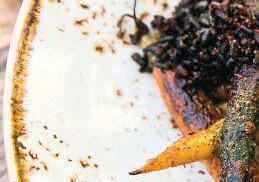

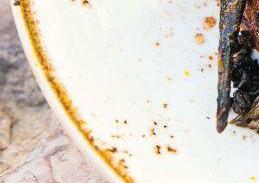



24 edible MONTEREY BAYWINTER 2017
ROASTED BABY CARROTS WITH CARROT PURÉE, FORBIDDEN COCONUT RICE, HONEY CASHEWS AND CILANTRO
Courtesy Paul Corsentino, executive chef, e Sur House, Ventana Big Sur Serves 5





Roasted Carrots: 4 bunches baby rainbow carrots ¼ cup olive oil Salt and pepper 2 tablespoons sumac
Preheat over to 375° F. Cut the tops of the carrots and reserve them in ice water. Scrub the carrots with a rough dish sponge and water to remove all dirt. Toss the carrots in the salt, sumac and olive oil, and place on a baking sheet. Roast the carrots at 375° F until they are tender (about 25 minutes).
Carrot Purée: 1 quart carrot juice 3 large carrots 1 tablespoon olive oil Salt, to taste

Peel and rough-chop the carrots and cover in a pot with the carrot juice. Simmer until carrots are fully cooked. Reserve the juice. In a food processor, purée the carrots until they are smooth, along with the olive oil and a touch of the juice, if needed. Adjust seasoning with salt, to taste.
Forbidden Coconut Rice: 2 cups Forbidden Rice 1 cup water 1 cup coconut milk 1 teaspoon honey 1 teaspoon lime juice Salt, to taste

Combine all ingredients in a pot and cover. Bring to a boil then turn down to very low heat and cook for about 25 minutes until the rice is tender. Pour the rice out of the pot and fluff. Adjust seasoning with salt.
Cashews: ¼ cup cashews 1 tablespoon honey 1 tablespoon canola oil Salt

Combine all ingredients and place on a baking tray. Roast in the oven at 350° F for about 10 minutes or until the cashews are golden.
Cilantro Pistou: 1 bunch cilantro ¼ cup olive oil Salt, to taste
Combine all ingredients and blend in a food processor. Season with salt.
To assemble: Place a tablespoon of the warm purée on the base of a plate. Place about five carrots on top of the purée in a crossover pattern. en place three different, small piles of rice in three corners of the plate. Sprinkle the cashews over the carrots. en drizzle the cilantro pistou over the carrots, and garnish the dish with the reserved carrot tops.

www.ediblemontereybay.com 25










26 edible MONTEREY BAYWINTER 2017







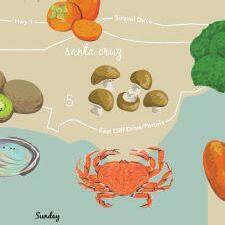


























www.ediblemontereybay.com 29








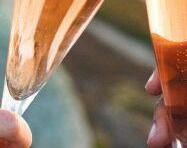








30 edible MONTEREY BAYWINTER 2017
POP STARS
Local winemakers get out in front of the sparkling wine boom with lots of pink and a rainbow of quirky new bubbly varieties.
BY DEBORAH LUHRMAN PHOTOGRAPHY BY MICHELLE MAGDALENA
It was already fall. Days were getting shorter, nights were getting colder and the chardonnay grapes at Beauregard Vineyards’ Bald Mountain Vineyard in Bonny Doon still had not ripened. “e plants were shutting down and losing their leaves. All of the fruit was under-ripe—it was just unacceptable,” recalls winemaker Ryan Beauregard.
So Mother Nature forced his hand and Beauregard used the under-ripe grapes to make his very first Champagne-style sparkling wine—a type of wine that requires highly acidic, immature fruit. “It’s a scary investment in equipment and time, but it forced us to take the risk,” he says.
Little did Beauregard know that by the time the 2010 harvest was released six years later, the wine world would be in a fullfledged frenzy over fizz that transcends the traditional holiday season.
According to Nielsen research, sales of U.S. sparkling wines increased 8% in 2016— impressive growth, although it paled in comparison to sales of prosecco, the Italian sparkling wine, which soared by 27%. Spanish cava and French Champagne also racked up strong growth.
“Everything is bubbles these days and our rosé has been huge,” says Beauregard of his bone-dry, salmon-colored 2010 Brut Rosé Nature, available only at the Beauregard tasting room in Bonny Doon.
“Sparkling wine is not a fad,” he says. “It’s going to be around for a long time, and we all have a lot of catching up to do.”
e 42-year-old winemaker taught himself to handcraft sparklers by watching how-to videos on YouTube. Just 30 cases are produced at a time using six riddling racks, where each bottle is turned by hand day after day until all the yeast and sediment collect in the neck and can be frozen and disgorged—another painstaking process—and then sealed with a hand corker. In addition to the rosé, Beauregard’s pristine 2013 Brut Nature Blanc de Blancs is also currently available in the tasting room.
“I’m not convinced there is any money to be made in sparkling wines,” he says. “We do about five times more work than with still wine and wait six to 10 years for them to be ready. But we want to make sure all our products are 100% vertically integrated, from ground to glass. We own the land, we tend the grapes, we make the wine. It’s 100% in the hands of the family.”
FIZZ DOCTOR
While Beauregard prefers to go it alone, most of his fellow local winemakers get a helping hand with their sparkling wines from Barry Jackson of Equinox Cellars in Santa Cruz.
Jackson, who started Equinox just before the Loma Prieta earthquake in 1989 and opened his tasting room at the Swift Street Courtyard two years ago, is clearly enjoying the renaissance in sparkling wines.
“We’ve had so many ups and downs I could have called this place yo-yo cellars,” he jokes, admitting that business is booming both
at the tasting room and back at the winery, where he makes custom bubbly for 16 area wineries—among them Bonny Doon, Ser, Odonata, Windy Oaks, Silvertip and Hahn.
“ey produce the base wine from their own or purchased grapes and send it to us to add the fizz,” he says. “We put it through the (méthodeChampenoise) process and age it two to four years in the bottle.”
Out of 5,000 bonded wineries in California, only 30 to 35 have the equipment needed to make sparkling wine, and just four of those—including Equinox—handle custom work, according to Jackson.
Some of the wineries he works with have amped up production by 50% recently, and his warehouse is stacked floor to ceiling with pallets of Champagne quietly awaiting their moment to party. A commercial-grade gyropalette can turn 480 bottles at a time, and his bottling line can disgorge up to 2,000 bottles “on a good day.”
“Millennials are easily two-thirds of our customers,” says Jackson. “As a group they are a little more adventurous and looking for new things. ey are enjoying sparkling wines more, especially those not made from mainstream varieties.”
Equinox’s 2013 Monterey Rosé is all the rage at the tasting room and easily outsells the crisp and toasty Blanc de Blanc Monterey Cuvee de Chardonnay. But Jackson says local winemakers are increasingly turning to unusual varietals, like the sparkling albariño first made locally by Bonny Doon Vineyards and
www.ediblemontereybay.com 31
BEHIND
THE BOTTLE
now by Windy Oaks. Deep-red sparkling syrah, sparkling grenache and sparkling rosé of Sangiovese have all rested in his warehouse recently, perhaps making Santa Cruz the capital of quirky bubbles.
“I refuse to stop calling them Champagne, just to annoy my French friends,” he quips, in reference to the European Union law requiring anything labeled Champagne to come from the Champagne region of France.




Well-made dry sparkling wines are the ultimate food wine, according to Jackson, and go well with a wider variety of foods than any other style of wine—everything from sushi to pasta and any kind of seafood. In fact, his very favorite pairing is sparkling wine and a potato chip with a dab of caviar.
For that extra special occasion, Equinox just released a 2001 vintage Blanc de Blanc made with chardonnay from the Trout Gulch Vineyard in the Santa Cruz Mountains and aged 15 years with yeast in the bottle. e longer the wine is in contact with the yeast, the more the taste develops, and this one is a knockout.
QUIET CLASSIC
Meantime, one of the most extraordinary sparkling wine houses in the U.S. is hiding in plain sight. Caraccioli Cellars—with a friendly tasting room in Carmel and the renowned Escolle Vineyard in the Santa Lucia Highlands— is a perennial award winner.
It was founded in 2006 by grower Gary Caraccioli and winemaker Michel Salgues, a Frenchman from the Champagne region originally sent to the U.S. to oversee production of sparkling wine at Roederer Estate.

“Michel met my dad and liked that we weren’t going to cut any corners. He had carte blanche to do everything he wanted,” says 34year-old Scott Caraccioli, now general manager.



Sadly, Michel passed away on Oct. 1 after a year-long illness. “He was my mentor in everything,” Caraccioli says. “He was a firm believer in controlling everything from the pruning to the harvest and I believe that’s how you make the best sparkling wines.”
Caraccioli grapes are harvested early, for low sugar content and optimal acidity. ey are picked at night using small yellow totes
32 edible MONTEREY BAYWINTER 2017
Scott Caraccioli, general manager of Caraccioli Cellars
to protect the grapes and a gravity press used to get only the “heart juice.”
“It’s a matter of recreating Michel’s recipe at this point,” he adds. “It’s easy to make concessions, but every detail matters. Wine will tell you what was done right and what was done wrong.”
Caraccioli says Monterey County is the perfect place to make sparkling wines because the two classic varieties used in Champagne— chardonnay and pinot noir—thrive on the region’s cool nights and marine influence, characteristics which are also present in the Santa Cruz Mountains.


His 2007 Brut Cuvee was named Best Sparkling Wine in the U.S. at the Champagne & Sparkling Wine World Championships, and the 2010 vintage just won Best California Brut Blend. Also this year, Caraccioli’s 2012 Brut Rosé won Best of Class.





“It’s been the most popular wine we’ve ever launched,” he says. “Rosé is softer on the palate. Ripe fruit balances some of the green apple acidity of the chardonnay. It’s hard to make a balanced rosé and Michel excelled at that from the get-go.”
Caraccioli has noticed the uptick in demand for sparklers and hardly a week goes by without a winemaker calling to ask whether he does custom work. He doesn’t.

But like Beauregard, he thinks the current boom is not just a passing fad. “California is still relatively young as a wine region and making sparkling wine is a capital-intensive, lengthy process. But we’ve gotten better at it and more people are doing it,” he says. “As people have a positive experience, it is easier to open the door.”
BEYOND THE BUZZ
No one is popping corks at Bonny Doon Vineyards. at’s because all the sparkling wines created by winemaker Randall Grahm, so far, come with easy-open bottle caps. He currently has a méthodeChampenoise red sparkling pinot noir and meunier blend called Pinot Doonier available at the tasting room in Davenport and a sparkling grenache, set to be released in the spring.
“People are missing the boat about sparkling reds,” says Grahm. “ere has been a kind of phobia about them, but sparkling reds are unspeakably cool.”
www.ediblemontereybay.com 33
Equinox Cellars’ méthod Champenoise master Barry Jackson and his wife, Jennifer
e project he is most excited about at the moment is a new sparkling pink French wine slated to be released before summer 2018. “I think there is a market for it and we’re even thinking about bottling [it] in cans, which is kind of wacky,” he says.












Grahm traveled to France in October to oversee the blending process for the cinsautbased project. “Pinot noir makes the most exquisite sparkling wine, but we can’t afford pinot and I think cinsaut can be quite elegant as well; it is very fragrant and smells like cherries.”

e base wine was made in the Midi region of France and is being trucked to Provence for secondary fermentation. “is won’t be bottle fermented,” he says. “We’re making a proper tank-fermented sparkling wine using the Charmat Method, which gives a good mousse and finer bubbles.”

While the name of the new pink sparkler is still under wraps, Grahm assured us the label will include his signature “flying cigars” and the words Bonny Doon Vineyard. But even for the pioneering winemaker, this project is a new adventure.
“I don’t do anything ordinary; it’s too boring and not my thing. Life is short, so why do the same thing as everybody else?” he says.

Bubbles are anything but boring. ey used to be synonymous with celebrations, New Year’s Eve and weddings, but increasingly are enjoyed anytime at all—in place of a cocktail, for a picnic at the beach and with dinner.
“ere is something about the bubbles and the movement that make it an event,” says Grahm, adding simply, “Bubbles make me happy.”





Deborah Luhrman is deputy editor of Edible MontereyBay and editor of our weekly newsletter. A lifelong journalist, she has reported from around the globe, but now prefers covering our flourishing local food scene and growing her own vegetables in the Santa Cruz Mountains.
MORE: For more local sparklers to try, go to the online version of this story at www.ediblemontereybay.com.
34 edible MONTEREY BAYWINTER 2017
Jim and Ryan Beauregard of Beauregard Vineyards






















36 edible MONTEREY BAYWINTER 2017
ON THE FARM
GOING ORGANIC
Decades after the Monterey Bay area established itself at the vanguard of the organic movement, consumer demand is spreading organic growing practices throughout the region
BY KATHRYN MCKENZIE PHOTOGRAPHY BY PATRICK TREGENZA
e exhibit halls at the Hyatt Regency Monterey Hotel were full to bursting—so packed that it was hard to move, so noisy that you had to shout to be heard. And what lured these excited crowds from every part of the country? Organic produce! Room after room rolled out colorful displays featuring lettuce, zucchini, potatoes and mushrooms, herbs and tree fruit, ready-made salads and shredded veggies, as people swirled around the tables grabbing samples.
Everything being shown at the Organic Produce Summit last July was, of course, organic—and what people were talking about most was how to meet the overwhelming hunger by consumers for fresh, certified-organic produce, which posted sales of $15.6 billion last year, according to the Organic Trade Association. Not only were there representatives from Safeway and Albertsons, but also from grocery stores across the United States as well as online purveyors including Amazon Fresh, FreshDirect and Blue Apron.
Such an event seems only natural for Monterey, located in the heart of organic produce country. “Monterey, Santa Cruz, San Benito counties—we are the cradle of organic produce for North America,” says Matt Seeley, founder of the OPS and co-founder, with Tonya Antle, of the Organic Produce Network. “is is the area that people turn to.” And obviously the tricounty area has heard the call and responded, with organic acreage increasing more than fivefold, from 14,000 to 78,000 acres in crop and pasture lands over the past five years, and gross sales nearly doubling, from $328 million to $574 million.
Overall, organic acreage in the tricounty area is up to about 7% of total crop and pastureland—seven times the national average of 1%. Driving the growth, says Monterey County deputy agricultural commissioner Graham Hunting, is the steady movement of large- and medium-sized growers to convert acreage to organic. “Larger operations have the bandwidth of logistical staff to handle the increased paperwork and documentation from organic management,” he says, also noting that certified organic produce is more valuable as a commodity, reaching higher price points and maintaining value through low price seasons, and that consistency has motivated larger growers to pursue organics.
e Organic Produce Summit, now in its second year, is an undeniable success. “ere was this massive multibillion-dollar industry that did not have a go-to event,” says Seeley. “I saw an opening.”
Seeley is now busy planning a new event, the Organic Grower Summit, a collaboration between OPN and CCOF, which will also be at the Hyatt in Monterey, Dec. 13–14, and will be aimed at bringing together growers with experts in seed, soil, food safety, technology and packaging. And hot on its heels, Jan. 24–27 at Asilomar Conference
Center in Pacific Grove, will be the 2018 EcoFarm Conference, which has been gathering organic farmers for sustainable farming education, networking and advocacy for nearly 40 years.
A GROWING HUNGER FOR ORGANICS
“Consumers are concerned about what’s going on inside their bodies,” Frances Dillard, director of marketing for Watsonville-based Driscoll’s, the huge grower of organic as well as conventional berries, told a tour group during the OPS last summer, noting that more than 80% of U.S. households are now buying at least some organic produce. “Young, affluent families are the primary source of the demand.” Millennial moms from households making $90,000 per year are the typical customers.
e No. 1 reason why people buy organic, marketing surveys have found, is a desire to eat healthy food. It’s all about “young families having children, wanting to do something better for their kids,” says Antle, a pioneer in the organic world, pointing out that baby food is a huge organic category. Not only do organics provide federally regulated certification that foods are not grown with pesticides or chemical fertilizers prohibited by the label, they also provide more bang for the nutrition buck: a 2008 review of 97 published studies found organic foods are more nutrient dense on average.
Millennials also consider pesticides’ impact on the environment, although surveys say it’s fourth on the list of motivations for buying organic. No. 2 is avoiding genetically modified produce (GMOs are prohibited under the organic label); No. 3 is taste.
But the benefits of organics are multidimensional: It’s safer for farmers and farmworkers, and better for land and water, Antle notes. Creating a living soil that can function as it’s supposed to also helps store carbon in the soil, reducing its impact on the atmosphere and curbing global warming.
Still, there has not been enough of an increase in organic acreage in production locally to make a large difference. e Pesticide Action Network of North America, which tracks such trends, says the total pounds of pesticide used per acre in Monterey, Santa Cruz and San Benito counties have fluctuated but haven’t really gone down significantly—yet.
e image on opposite page, of John Jeavons of Grow Biointensive, is from the new film, Evolution of Organic, which tracks the history of the movement. See sidebar, p. 41.
www.ediblemontereybay.com 37
Photo from the film Evolution of Organic courtesy of the filmmaker
THE LOCAL ROOTS OF A MOVEMENT


e Monterey Bay area has been at the forefront from the beginning. e organic movement bloomed here in the 1960s, fueled by the counterculture’s back-to-the-land vision and new concerns about the environment and pesticide use. A new documentary by Mark Kitchell (see sidebar p. 41) traces the movement from its early days at UC Santa Cruz under Alan Chadwick, its nurturing by groups like EcoFarm, to when Drew and Myra Goodman’s Earthbound Farm pulled together growers and shook up the organic marketplace, and when Antle introduced organic produce to conventional supermarkets.

ese days, with big growers ramping up their own organic production, consumers across the U.S. can buy an array of fresh organic produce just about anywhere—independent markets and nationally known chains, and even giants like Walmart and Costco stock organic produce as staple products.
And that’s very good news for Monterey Bay area farms, which grow much of the lettuce, spring mix, broccoli, Brussels sprouts, artichokes and other specialty crops that go out to the rest of the country.
While Salinas Valley powerhouse growers are increasing their organic acreage, other changes are happening up and down the supply chain—organic seed purveyors are breeding for specific traits to attract shoppers; growers are looking into innovative ways to get more out of their organic acreage; and processors are dreaming up new products starring organics.
And it’s just the start, in Seeley’s enthusiastic view. e future is “stunningly bright,” he says, especially when food service goes organic in a big way—something that he feels is just around the corner. If most restaurants, fast food places, caterers and cafeterias choose organic, demand will increase even more; production will catch up; and ultimately the cost of production will go down, he says: “It’s the ultimate game changer.”

California, as you might expect, leads the way in U.S. organics, producing 38% of all organic produce in the nation, and more than 2,700 California farms are certified organic. Locally, each of the region’s counties has long fostered the proliferation of the kind of smallscale family organic farms that have traditionally fed the local and sustainable food movement. What’s more recent is the growth of large new organic farms or organic sub-labels of large conventional farms and packers, joining Earthbound, which started in Carmel Valley more than 30 years ago and eventually moved to San Juan Bautista, in the “big organic” sector. In the Salinas Valley, for example, Braga Fresh Family Farms, Mann Packing, e Nunes Company, Tanimura & Antle and Taylor Farms all have introduced organic labels, Nunes under Foxy Organic, Braga under Josie’s Organics and the others under their own names. In Santa Cruz County, Lakeside Organic Gardens and Driscoll’s are among the major organic growers.
Berries are a particularly big seller in organics—possibly due in part to the fact that conventionally grown versions wind up on the Environmental Working Group’s “Dirty Dozen” list, testing positive for
eir fields are organic: clockwise from upper right, OPN’s Tonya Antle, e Nunes Company’s Mark Crossgrove, Taylor Farms’ Nicole Flewell and Josh Roberts, OPN’s Matt Seeley, and EcoFarm founder Amigo Bob Cantisano with ALBA’s Nathan Harkleroad.
38 edible MONTEREY BAYWINTER 2017
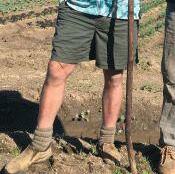


























www.ediblemontereybay.com 39
Photo top left by Kathy McKenzie; others this page by Patrick Tregenza
pesticide residue, with strawberries at the top. Driscoll’s has seen double-digit growth in its organic products.
To keep up with demand, the company’s research and development team is exploring options such as elevated berry beds: ey are easier on workers’ backs, offer better control of soil and water usage, and are simple, although not cheap, to set up and maintain. Such outof-the-ground methods, though, have been controversial and hotly debated among growers, with diehard organic farmers believing that only crops grown in soil underfoot should qualify for the coveted “Certified Organic” label.
Part of the problem with the appetite for organics is that it’s tough to convert farmland fast enough to keep up with demand. It takes three years to transition acreage from conventional to organic production; certification takes time, paperwork and expense.
e Nunes Company, headquartered in Salinas, is one of the large local growers that have followed consumers’ lead to add organics to their previously conventional-only product line. Executives there began looking at the idea of organic produce in the early 2000s, after receiving inquiries from their customers about it. In 2005, the company started transitioning some of its best conventional acreage to organic, and by fall 2008, was shipping two organic produce items—romaine hearts and celery.
Now, the company (owners of the Foxy and Foxy Organic brand names) ships 35 different organic items from its growing regions in California, Arizona, Nevada and Mexico. To meet the demand, e Nunes Company expanded production areas and opened a state-of-the-art cooling and distribution center in Yerington, Nev., earlier this year.
“e organic market continues to grow, although it’s growing at a much slower rate than it was three to five years ago,” says Mark Crossgrove, senior vice president of sales and marketing at e Nunes Company. “Organic growers have many more challenges. eir costs are extremely high, and there is a need for greater returns for the growers to ensure the growth of organic production.”


It’s more complicated to grow produce organically—soil is built by adding compost or growing cover crops, rather than adding synthetic

fertilizers; pests are controlled via beneficial insect release or covering rows with fabric; and weeds are plowed or smothered in mulch. All of this takes more time, energy and attention than conventional methods.
To ensure a reliable supply of organic produce, Salinas’ Taylor Farms provides advice and support to its grower partners, both locally and across the country, says the company’s director of agricultural operations, Josh Roberts. Roberts’ job is to maintain relationships with growers and to get them what they need to succeed, which can span early-stage planning through harvest.
“We prefer to be as involved as the grower wants us to be,” says Roberts, who estimates that about 20% of Taylor Farms’ output of packaged vegetables and salads is organic. And more is on the way: about 5% of the company’s total acreage is presently being converted to organic, year over year.
“Our core focus is giving the customers what they want, and that means a consistent supply. at’s our primary challenge,” says Roberts.
Taylor Farms is committed to sustainability companywide, with all its growers having pledged to use sustainability measures whenever feasible, such as integrated pest management and drip irrigation on particular crops. e company also uses a combination of natural gas-powered cogeneration, solar and wind, to run its facilities, supplying its Gonzales plant with more than 90% of its power needs, says Nicole Flewell, the company’s director of sustainability. Taylor Farms is also making great strides toward curbing water consumption and landfill waste, and donates more than 3 million pounds of produce to food banks and charitable organizations each year.
“At Taylor Farms, sustainability is part of our DNA. We have a responsibility to be good stewards of the environment, and leave the world a better place than we found it,” says Flewell.
HOW DOES THIS AFFECT THE SMALL GROWERS?


It seems as though those long-ago organic aspirations of the 1960s are finally being internalized by big business. And yet, what does all of this mean for the small farmers? If customers can stroll into Safeway and

40 edible MONTEREY BAYWINTER 2017
Photo from the film Evolution of Organic, courtesy of the filmmaker
EVOLUTION OF ORGANIC
Long-haired, shirtless young people plant rows of vegetables, music from the Grateful Dead fills the air and garden guru Alan Chadwick intones a dire warning in the opening scenes of the brand-new documentary, Evolution of Organic e uplifting and entertaining film, narrated by actress Frances McDormand, traces the organic sector from its counter-culture roots in the 1960s to the present day, telling the story of its unexpected growth and some of the missteps along the way—with songs by Country Joe, Bruce Springsteen and even the Banana Slug String Band all getting airtime before the closing credits roll.

Evolution of Organic is an independent production made over the past two years by Mark Kitchell, a San Francisco-based filmmaker known for documenting social change movements. His previous work includes the Academy Award-nominated
the environmental movement.
“I was envious of people who were already making films about food and ag, like Food, Inc. and Symphony of the Soil. I saw that this was a story that really had legs and the most mojo of any social movement right now,” Kitchell said about his inspiration for the film. “People love organic and are passionate about where their food comes from and how it’s grown.”
Filming took Kitchell throughout Northern California. His first stop was the EcoFarm conference in Pacific Grove in January 2015. It doesn’t take long to begin spotting local folks in the film, such as Steve Pedersen of High Ground Organics, Joe Morris of Morris Grassfed Beef, Tonya Antle of the Organic Produce Network, Jim Nelson of Camp Joy Gardens and Amigo Bob Cantisano, the heart and soul of EcoFarm.
Kitchell is a skilled archivist who fills the screen with historic clips and amusing photos of the barefoot, bare-breasted hippie origins of the organic movement.


He describes how the efforts grew from an act of rebellion to the beginnings of “foodie-ism” with Alice Waters and Chez Panisse-style chefs looking for ingredients that tasted better, then on to government regulation, mainstream supermarkets and the conversion of big conventional farms to organic.
“We can’t have all just little hippie farms. If we are going to really have major change, we need these large-scale conventional farmers to see the light, to succeed and to push the envelope,” Cantisano says in the film.
e film maintains there are now two strains of organics: the industrial organic sector which provides food—much of it from our region—for supermarkets across the country, and the organic movement, which is still alive on small family farms that sell through CSAs and farmers’ markets.

Looking towards the future, Kitchell sees great hope in carbon farming through organic agriculture and regenerative grazing: Plants grown using these regenerative methods capture the greenhouse gas carbon dioxide from the air and process it through photosynthesis into little stores of carbon, which travel down through the roots and into the soil to feed the micro-organisms, rather than polluting the atmosphere and contributing to global warming.
“All the film is leading up to our big breaking story of carbon farming, which is potentially the biggest solution to climate change,” he says. “It is all tied into soil and microbes and putting carbon back into the ground where it belongs. is gives organic a new sense of purpose.”
Evolution of Organic was screened at the Carmel International Film Festival in October and a screening in Santa Cruz is in the works. It will be available for streaming on Amazon, Netflix and iTunes in 2018.
e festival has made a multi-year commitment to spotlight films about agriculture and has already announced that in 2018 it will screen the upcoming Redford Center documentary Kiss the Ground, all about carbon farming.
- Deborah Luhrman
www.ediblemontereybay.com 41
film Berkeley in the Sixties and A Fierce Green Fire, which documents








42 edible MONTEREY BAY WINTER 2017
easily buy an organic peach, will it eliminate the need to shop at the farmers’ market or to buy from a CSA? After all, most organic farmers operate on fewer than 100 acres. How do they compete with the major players in the Salinas and Pajaro valleys?
Surprisingly, local farmers’ market organizers aren’t worried about it, and view the big organic trend as a tide that lifts all boats. Catherine Barr, who heads Monterey Bay Certified Farmers’ Markets, says it really is a good thing: “Because of farmers’ markets, some of our local organic farms are now appearing in traditional grocery stores. I feel that farmers’ markets have influenced grocery stores to ‘buy local.’ Why would you want an apple from Washington when we have them in our own backyard?”
She believes that farmers’ markets are not likely to lose their customers any time soon, since people who are in the habit of frequenting them aren’t suddenly going to stop. Farmers’ markets also offer unique and shorter-shelf-life items, such as heirloom varieties that aren’t going to be carried in grocery stores. Most importantly, she says, those customers “have built up a great trust with that farmer growing their food … e social aspect between the consumer and farmer is very important.”
at connection to the customer is what keeps small farmer Ronald Donkervoort going. e Netherlands native, who has been farming on the Central Coast for 30 years, sells the products of his Moss Landing Windmill Farm only at farmers’ markets and to a few select restaurants. But it’s becoming tougher to make a living at it.


“It’s a mixed bag. ere’s a greater demand for organic foods, and I can never be against that,” Donkervoort says. “But it’s getting tighter for the smaller grower.” His costs have doubled during the last three decades, and now it is more difficult to raise his prices with all the increased competition. Still, “I manage to survive … I choose to do this,” he says.

Small farmers are also adjusting to the current marketplace by coming together and forming cooperative ventures, or turning to companies such as Watsonville’s A&A Organic Farms, which sells and markets produce for its small growers, and assists them with crop plans, package design and marketing strategies.
ALBA, the Salinas Valley nonprofit that helps small farmers get a foothold in the business, also views the organic boom as good for everyone. Nathan Harkleroad, ALBA’s education program manager, says he is encouraged by the increasing prevalence of organics everywhere, and that ALBA seeks to help farmers sell their organic produce to Whole Foods and Trader Joe’s, partnering with Aggrigator, which connects small farmers with big distributors.
As far as Matt Seeley is concerned, farmers of every size should be included in the organic gold rush. “It’s a very diverse community and we have a large tent,” he says. As for the newer, larger growers, “ey are responding to the marketplace … We are blessed here with some of the most progressive growers in the entire world. It makes sense for a lot of these guys to respond to the demand.”
Kathryn McKenzie, who grew up in Santa Cruz and now lives on a Christmas tree farm in north Monterey County, writes about sustainable living, home design and health for numerous publications and websites.

www.ediblemontereybay.com 43
BACK OF THE HOUSE
WOMEN IN THE KITCHEN
Women chefs are well represented in top posts around the Monterey Bay, and we talk to three of them about how they’ve achieved success in what has traditionally been a man’s world.
 BY PATRICE VECCHIONE PHOTOGRAPHY BY MICHELLE MAGDALENA
BY PATRICE VECCHIONE PHOTOGRAPHY BY MICHELLE MAGDALENA



For most of us, our first meals came from women—our mothers, and later, if we’re women ourselves, we tend to become the home cook. Like countless middle-class American women of the 1960s and ’70s, my mother was a devotee of Julia Child. ough she worked full time at a demanding job outside our home, as soon as she got back from work, just after opening a beer, happy in the kitchen, my mother began preparing elaborate dinners, like shrimp jambalaya or crab crêpes, and what was newly popular in the United States, quiche Lorraine. How is it that women who for eons have been home cooks don’t dominate professional kitchens? ere, men stand at the top of the field—in terms of prestige, position and, especially, in numbers—as they do in so many others. Deborah A. Harris, co-author with Patti Giuffre, of Taking the Heat: Women Chefs and Gender Inequality in the Professional Kitchen (Rutgers University Press, 2015), says that because home cooking is unpaid work, it is “given less value and viewed as an expression of caring about others.” ere’s the rub, isn’t it?



Only 21% of American chefs and head cooks are women, according to the most recent figures from the Bureau of Labor Statistics. Of the Michelin-starred chefs worldwide, just 1% are women.


In 2017, how can this imbalance still exist? “It’s a combination of the history of the occupation in which women were excluded from cooking schools and professional kitchens for many years, along with development of a masculine work culture that makes it difficult for women to fit in and become accepted,” Harris says. en there are the long hours and, she adds, “e lack of health and maternity benefits, that makes it difficult for women to balance work and family.” A woman’s place may be in the kitchen, that is, as long as she isn’t earning her living there.
In truth, the myriad reasons why individual women decide to become professional chefs and why others choose different careers are as diverse, vibrant and stereotype defying as the half of the human race that women represent.






44 edible MONTEREY BAYWINTER 2017
A woman’s world: from left, Gabriella Café’s Gema Cruz, Art of Food’s Wendy Brodie and Sierra Mar’s Elizabeth Murray all have or currently run restaurant kitchens in the Monterey Bay area.
And here in the Monterey Bay area, we’re quite well represented by female chefs—many of them not just head chefs, but the owners of the restaurants where they cook. In Santa Cruz, there are Kendra Baker of e Penny Ice Creamery, Jessica Yarr at Assembly, Katherine Stern at La Posta and Ayoma Wilen at Pearl of the Ocean, just to name a few. In Pebble Beach, there is Angela Tamura of Pèppoli; in Carmel, Michelle Estigoy at Cultura Comida + Bebida; and in Carmel Valley, Sarah LaCasse at Earthbound Farm. In Monterey there is Stone Creek Kitchen’s Kristina Scrivani and in Moss Landing, Kim Solano, creator of e Haute Enchilada. In Aptos, Cori Goudge-Ayer heads Persephone and Ella King, Watsonville’s beloved Ella’s at the Airport. And not only is this list not the half of the women chefs leading local brickand-mortar restaurant kitchens—it doesn’t begin to count the legions of women chefs who have established thriving local catering businesses.
What follows are conversations conducted earlier this year with three local women chefs about the very different routes they have taken to their professional kitchens and the very different chef’s lives that they have forged.
THE PIONEER
Wendy Brodie is a bright-eyed and lively woman. She’s someone who may return an email with a phone call if she feels conversation would serve best, a rare and welcome gesture these days! Mention her name to anyone in the business and they’ll have only good things to say.
A graduate of the first class of the California Culinary Academy of San Francisco, a celebrated chef and caterer, she was co-owner of the popular Lincoln Court restaurant in Carmel and over her long career has held executive chef positions at such prestigious resorts as e Preserve at Rancho San Carlos and Stonepine Inn. In 2011, she was inducted into the Disciples of d’Auguste Escoffier. She has cooked with such celebrity chefs as Julia Child and Martha Stewart.
I was delighted to be invited to her gorgeous Carmel Highlands home called Zenwood to chat. With its open floor plan and sweeping ocean views, it’s a place where she frequently hosts dinners for those who want to throw a party but aren’t so skilled in the kitchen or whose homes can’t accommodate a crowd. She also teaches and hosts a local, weekly television cooking show, e Art of Food. On a rainy afternoon, with cups of hot tea in hand, we sit down for a leisurely, rambling conversation about her work. Like a racehorse, she says, “I can go around the clock for two or three days non-stop. I get passionate about an event and its overall creation. en I love the collapse afterward and the time spent in reflection.”
About teaching, Brodie says, “I love sharing what I’ve learned along the way so people can make it their own. When they learn cooking methods, they’re free from being recipe driven and can be at the farmers’ market or the supermarket and get inspired by what they see, knowing how to mix this and that. You know, you can give 10 chefs a chocolate chip cookie recipe and you’re going to get 10 different versions.”
For years, Brodie cooked outside her home. “In a restaurant, the line is a machine.” Because so many people who’d go to her restaurant, Lincoln Court, knew her and would want to say hello, she could be seen nearly in flight running between the kitchen and the dining room, but she loved it.
About her time as head chef at Stonepine and e Preserve, she says, “ere were usually set-course meals, and buffets were set up, so I got to also be at the front of the house; it was kind of like a home situation. I could do the centerpieces and flower arrangement. ere was a whole creative element to it.”
Commenting on the role gender plays in the restaurant business, she says, “Many of us have the vantage point of the woman being the main person in the home, the center of home. For me, it’s very comfortable to be able to give and cook and share, though my mother really didn’t know how to cook. Her mother had been a great cook who never passed it on. My mother used to say, “Wendy, you came from a dysfunctional kitchen!’”
As far as having a family of her own, Brodie felt her career limited her choices.
“I realized that if a woman working in a restaurant had a family, she couldn’t run home to a sick kid,” Brodie says. “A guy can have a family and kids and that’s fine. But a woman doesn’t really have that liberty unless there is someone at home taking care of things.” Consequently, Brodie chose to forgo having children. “I never felt it was an option for me,” she says.
As for what she appreciates about the culinary world these days, Brodie says, “ere’s joy in seeing garden people find an heirloom variety that hasn’t been grown in years, or mixing the apricot and plum together to create something new. I love the colored carrots, too—so many things for the culinary artist to be excited about.” And she appreciates the concept of global cuisine, something that the culinary academy didn’t offer at the time.
THE NURTURER
Gabriella Cafe is a Santa Cruz favorite and, as I recently discovered when I came to interview head chef Gema Cruz in the cozy dining room before dinner service started, if you don’t have a reservation for Saturday evening, you may be out of luck. A busy night will have the place serving 100 dinners.
Cruz credits her grandmother for her career choice, and Cruz’s memories of watching her grandmother prepare meals from what the family grew at their rural Oaxaca home continue to inspire her.
www.ediblemontereybay.com 45
“Mija, I’m working because I like it and because I want a better life for you. I don’t have time for tired, and once I’m cooking, I’m not tired anymore; I’m transformed. My kitchen is a sacred place.”
Cruz paid close attention to her mother and grandmother as they prepared the family’s meals in their simple home. She saw how hard these women worked, starting early in the day, cooking and cleaning up until late at night.
From her grandmother, she learned, “When you cook happy, your food is delicious because your whole emotion is coming through your body, through your hands and your feet.”
Cruz gets excited telling me about the foods that she grew up eating. “We ate what was on our farm, and rabbit. It’s easy to catch a rabbit in the mountains where it’s harder for poor people to get other protein like beef. You can make a lot of things with the food we grew like pumpkin and corn. In Mexico, you use everything you have. You eat the pumpkin and the seeds, and with corn you use the leaf, too.”
Using sustainable techniques has been a part of Mexican culture forever. What the people don’t eat, the animals do. “Nothing,” says Cruz, “is thrown away.”
Foods from her childhood that she cooks with today include yucca, which she prepares like sweet potatoes, and the herb pápalo Very strong in flavor, it’s almost a mix between cilantro and arugula. “It comes from Puebla, Mexico,” Cruz says, “One of the local farmers got the seeds because I asked, and he grows it for me!” And what does one do with pápalo? “Mix it with cream and lemon for a sauce to serve on fish,” she says. “It’s totally delicious!”
When she was 17, Cruz’s family left Mexico for California. Shortly after her arrival here, she and her mother began preparing lunches-togo for fieldworkers. Word about her food spread quickly and she began getting requests for holiday dinners and school functions.
Cruz began as a dishwasher at Gabriella Café. Yet, once owner Paul Cocking took her up on her offer to cook, she became the chef. And not just any chef, “the best chef I’ve ever had,” he says. Today, Cruz expertly fills an esteemed post previously held by such local legends as Jim Denevan, Sean Baker and Brad Briske.

What Cruz brings to Gabriella Café is a family and cultural tradition of feeding and caring for people that she blends with a creative approach to food.


When guests visit the restaurant and request something special or have a food allergy, Cruz says, “yes,” and adjusts the ingredients to accommodate them. “Say I’m making rabbit with guajillo sauce and someone doesn’t want guajillo. en I’ll do it Italian style, with prosciutto, sage and cheese. A lot of chefs say, ‘No, I only serve what I have on the menu,’ but I tell the waitresses, ‘You don’t have to come in and ask me. Just tell the person yes.’ And then I make them happy!” She loves doing that; she loves it when diners peek into the kitchen, as they often do, to personally thank her for their meals.
Cruz sees the difference between female and male chefs as a matter of motivation. Because women come from a long history of cooking for their families, she says the work has passion intrinsic to it—a dedication to pleasing people through food. “When I cook,” she says, “it’s like singing and dancing, that kind of happiness.”
Cruz’s children sometimes ask her why she works so much. Her reply is consistent, “Mija, I’m working because I like it and because I want a better life for you. I don’t have time for tired, and once I’m cooking, I’m not tired anymore; I’m transformed. My kitchen is a sacred place.”
THE RISING STAR
Sierra Mar executive chef Elizabeth Murray left her home state of North Carolina and worked for a while in Arizona before landing in Southern California where she cooked at San Diego’s acclaimed George’s at the Cove. From there, she says, “I kind of flew the coop, sold everything I owned, put my knives on my back and went to New York and then Europe.”
With a winter rainstorm quickly approaching, Murray and I sit down together in the bar of Sierra Mar, which is perched atop a cliff overlooking the Pacific Ocean at Post Ranch Inn.
46 edible MONTEREY BAYWINTER 2017
“I’ve never worked for a female chef,” Murray tells me. “It’s interesting for me, interviewing for chef de cuisine and sous chefs, in general, when somebody comes in who’s had a female mentor or worked for a female chef. I ask, ‘What’s that like?’” ey’re lucky people who will get those jobs, I’d bet, to have the chance to work for this woman chef. Murray is calm and confident, and she knows how to listen.
“I’ve worked with a lot of very aggressive and intense, brilliant, top-of-the-league chefs. From them, I’ve tried to take the good. For me, it’s all pretty new to be in that leadership role. I try to be as upright and respectful, creative, inspiring and team building as I can. If you’re building a team, you have to make your players shine,” she says.
“e person I’ve learned the most from was when I was at George’s at the Cove, working for Trey Foshee, a surfer. He was the most mellow chef of them all. Always respectful, he created positive work environments.”
Murray enjoys immersing herself in different cultures; she’s traveled extensively for her work—spending several months at Noma in Copenhagen before heading to Pappacarbone on the Amalfi Coast of Italy, where she learned by watching and doing. “It was all in Italian, so say I’d be working at the fish station, I’d just memorize names of the species of fish as they appeared on the tickets.” From Italy she took to Paris, working with a great butcher outside the city. During her time abroad, Murray found gender not to be an issue. What mattered was whether you stepped up and worked hard.
Having worked with Michelin-starred chefs, she reflects on the weight that comes with that honor: “If you’re a Michelin chef, that means you have a very specific idea in your mind about what you’re making—how it’s understood, how it tastes. at’s what a lot of the aggressive thing is about. You’re trying to get everybody to perfection. e people working for you need to have that kind of absolute dedication.”
Would Murray’s management style change were she to become a Michelin-star chef, I ask her. “I’ve been in a couple of kitchens where




they’ve received a star, been there before and after. I’ve seen that change,” she replies. “I think the people I might respect most in this industry are the people who give back the star. ere was a woman in Germany, recently, who gave back the star and stated, ‘At the end of the day, that’s not what I do.’ I know that Michelin gives recognition of the highest regard to chefs but it can make you do what you do for the wrong reason.”
Murray is thrilled to be running the kitchen at Post Ranch. She lives on the property so her life is concentrated right there in that gorgeous place, where she makes supreme food.
“We’re an internationally known hotel; we’re focused in our way and create a space that is unique. To me, that’s the mantra. If something else follows from that, great.” Here’s a chef not looking for what follows; she’s happily dedicated to what’s right in front of her.
BACK IN MY OWN KITCHEN
My perspective is one of a home cook, not a professional, but sitting down with Wendy, Gema and Elizabeth felt easy, the connection natural. A kitchen has always been one of the places where I’m most at home. Being able to make a meal out of almost nothing is second or, maybe, first nature. Feeding others is about as primal a satisfaction as I can imagine. Certainly, being a woman is part and parcel of this and, though my mother has been gone for 30 years, she often greets me in the kitchen, saying, “A little more garlic, sweetie, don’t you think?”
Monterey artist and writer Patrice Vecchione’s latest book is Step into Nature: Nurturing Imagination and Spirit in Everyday Life. For more, go to www.patricevecchione.com.
www.ediblemontereybay.com 47
THE PRESERVATIONIST YOGURT AND KEFIR
















 BY JORDAN CHAMPAGNE PHOTOGRAPHY BY MICHELLE MAGDALENA
BY JORDAN CHAMPAGNE PHOTOGRAPHY BY MICHELLE MAGDALENA
48 edible MONTEREY BAY WINTER 2017
Learn how to make nutritious and delicious cultured milk products in your own kitchen
I first made yogurt while living on a remote farm in Norway. It was a summer that truly changed my life. We would take a sunset walk about a mile out to pasture and call for the animals to come. e cows had about 5,000 acres to roam, but they would usually be near the gate waiting for us as the sun fell low in the sky. Ninny led them home so that she could feel the relief of being milked. Milking Ninny in the barn during the everlasting sunset of the far northern climate remains one of my most profound experiences. I always enjoyed the gentle sounds of her chewing and the soft feeling of her fur when I would nestle into her side as I milked her. On this isolated farm, it was astonishing how much nutrition came from this one animal and what sweet companionship she offered.

Often, we would take the warm milk, filter it into another clean bucket, add a certain amount of yogurt to it and cover it with a cloth to prevent contamination. en, we would rest that bucket in the corner of the mudroom, which had a heated floor. e next day the entire bucket would be yogurt and we would enjoy it for a whole week. We would eat yogurt and muesli for breakfast and yogurt and fresh berries as an afternoon snack.
Both yogurt and kefir offer ways to preserve fresh milk for a little longer by adding cultures to encourage coagulation and make the milk more acidic. Both are loaded with beneficial bacteria that make everything easier to digest and can aid in recovery from all sorts of ailments. Yogurt typically has two to seven different kinds of bacterial strains that can help clean and line the gut while nourishing the good bacteria, or probiotics, there. Kefir has 10 to 34 strains of good bacteria and beneficial yeast, which can also attach to the walls and colonize to create a healthy digestive tract.
YOGURT

roughout the process of making yogurt you need to keep the temperature at about 110° F. ere are many insulated chambers on the market to aid you in doing this, but they are not necessary. You can get creative and create your own warm environment. Some people use a heating pad, a small cooler containing a jar of hot water, a piloted oven or a hot water heater closet, a heated floor in a small room or a spot next to a wood stove. Conditions change from home to home but your goal is to keep the yogurt at 110° F for about 24 hours. You can test your environment by experimenting with a jar of water and leaving it overnight in your desired place and checking the temperature in the morning.
You will need a starter culture to make your yogurt. For this, you can use any commercial live-culture yogurt. Be sure the label says, “contains live cultures.” en you save a little of the yogurt you make to use as a starter for the next batch and keep it going from there.
KEFIR

Kefir is a fermented milk product that is started by a special colony of grains. ese grains are actually yeast and bacteria that look like curds, which you strain out of the kefir after fermentation and then use for the next batch—like sourdough starter. You cannot make kefir without this starter culture.

www.ediblemontereybay.com 49
Kefir’s roots lie in the Caucasus Mountains of Central Asia. Said to have been a gift from Allah, the first kefir grains were treasured by the people who possessed them and were not shared with strangers. So how did they finally migrate to the rest of the world? I have to quote my hero, Sandor Katz, here as he has written the story with perfection in his book, WildFermentation (Chelsea Green Publishing, 2016).
“Early on in the 20th century, the “all-Russian physicians’ society” became interested in obtaining the mysterious source of this healthful drink,” Katz writes. “Since the keepers of the grains did not wish to share them, this required deception and cultural thievery. e scheme involved a young Russian woman named Irina Sakharova, who the physicians hoped would be able to charm a Caucasus prince, BekMirza Barchorov, into giving her some kefir grains. He refused, she tried to leave, he had her kidnapped, she was rescued and he was charged in the czar’s courts. For reparations, the young woman was awarded the treasure she sought; the court ordered the prince to give her some of his cherished kefir grains. In 1908, she took the first kefir grains to Moscow. Kefir became, and remains to this day, a popular drink in Russia. In 1973, at age 85, Irina Sakharova was formally rec-
HOMEMADE YOGURT
Courtesy Jordan Champagne, chef and proprietor, Happy Girl Kitchen Co. in Pacific Grove Makes 1 quart
1 quart fresh cow’s milk
1 tablespoon yogurt culture (any store-bought yogurt labeled “contains live cultures,” or homemade)
Simply heat the milk to 110° F and add the tablespoon of yogurt culture. Gently stir in the culture and send in some good thoughts about the culture loving its new home and creating amazing yogurt. Let it sit in an insulated environment for 12 hours. e yogurt culture is very sensitive and does not like to be disturbed, so just let it be and do not fuss over it. After 12 hours, check it by tipping the jar to make sure that it is thickening. If it is not your desired thickness, let it go longer and be sure it is warm enough. You may need to adjust the environment somehow, by turning up the heat or adding another bottle of hot water to the cooler. e yogurt should be ready within 24 hours and will last two weeks in your refrigerator. Enjoy and remember to save some for the next batch.
To make Greek-style yogurt, simply hang your yogurt in cheesecloth for four hours or overnight. (is method strains out some of the watery whey and makes the yogurt thicker.) You can reserve the whey and use it to add a nutritional punch to smoothies, or for soaking oatmeal or making bread.
ognized by the Soviet Ministry of Health for her role in bringing kefir to the Russian people.”

I think it important to understand this part of the history of food preservation. We can easily take for granted that we can just order kefir grains from an online store and they will be delivered to our doorstep within two days. is story reminds us of a time when people knew the health benefits of food and were willing to risk everything to obtain just a few cultures. People also believed the health of their extended families depended on fresh kefir, and they protected it from outside invaders as the treasure that it was. It is a treasure just to get a glimpse of that kind of fervor for this healthy probiotic drink.
Jordan Champagne is the co-owner and founder of Happy Girl Kitchen Co. She has a passion for preserving the local, organic harvest and loves sharing her secrets at workshops she teaches in Pacific Grove and in Oakland.
HOMEMADE KEFIR
Courtesy Jordan Champagne, chef and proprietor, Happy Girl Kitchen Co. in Pacific Grove Makes 1 quart
1 quart milk—goat, cow, sheep or coconut 1 tablespoon kefir grains*
Pour the milk into a clean glass jar. Add the kefir grains and cap. If you do not want your kefir to develop too much effervescence, then put the lid on loosely. Leave the jar at room temperature for 24 to 48 hours, shaking it periodically. I put my kefir out on the countertop next to the stove where it is a little warm and out of the sunlight. In about 18 hours I find it to be perfectly cultured without becoming too sour or separated.
At this point, pour the kefir through a strainer to fish out the precious grains. Reserve the grains and use them for the next batch, storing them in a small jar covered in milk where they will keep for one month. e grains should continue to look whitish in color and plump with vitality. You only need one tablespoon of grains per quart of milk to keep your kefir going.
You can leave it out to continue to sour or refrigerate it and it will last about one week. Your homemade kefir will likely be sourer and more watery than the ones in the store. is is because commercial kefir contains thickeners and sweeteners. Embrace the homemade flavor!
*ese may be ordered online or strained from a friend’s batch of homemade kefir.
50 edible MONTEREY BAYWINTER 2017
















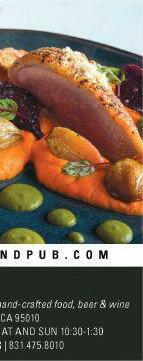


52 edible MONTEREY BAY WINTER 2017
Dine Local GUIDE



Cooking with local, seasonal, sustainable ingredients is a priority for AN EPICURIOUS LIFESTYLE’S Adrienne Megoran, seen here making Rainbow Carrot Ravioli. See p. 61 for more about this unique event, cooking and dining spacing in Santa Cruz.
All of these restaurants emphasize local ingredients, and they also advertise in Edible Monterey Bay! Stop by for a free issue, and tell them that we sent you!

BIG SUR
Sierra Mar at Post Ranch Inn 47900 Highway 1 • 831.667.2800 www.postranchinn.com

Executive chef Elizabeth Murray and executive pastry chef Ben Spungin use exceptional ingredients, many grown on site, to deliver a unique gastronomic take on the Big Sur experience. Dinner features a 4-course prix fixe menu and the 9-course Taste of Big Sur tasting menu; lunch offers 3-course and 5-course options. Choose from almost 3,000 different wines from the Wine Spectator Grand Award winning wine list. Arrive before sunset for breathtaking views from this iconic restaurant’s floor-to-ceiling windows and cliff-side terrace. Open daily for lunch 12:15–2:30pm, dinner 5:30–9pm.
CAPITOLA
East End Gastropub 1501 41st Avenue • 831.475.8010 www.eastendgastropub.com
East End Gastropub is the newer baby sister to the popular West End Tap & Kitchen, but aside from sharing owners and chefs, East End’s beautiful, recently renovated modern interior is entirely different from West End and offers its own robust, sophisticated, beerfriendly menu. Chef Geoffrey Hargrave has created dishes that are familiar yet innovative, such as the cacio e pepe farrotto with charred radicchio or the quinoa crusted Fijian albacore. e restaurant also offers its own brews, along with local rotating taps and a strong wine list. Open daily 11:30am–9:30pm.

e Penny Ice Creamery
820 41st Avenue • 831.204.2523
www.thepennyicecreamery.com
Open Su– noon–9pm, F–Sa noon–10pm
See e Penny description under Santa Cruz for more.
Shadowbrook

1750 Wharf Road • 831.475.1511 www.shadowbrook-capitola.com
A Santa Cruz County landmark since 1947, the worldfamous Shadowbrook continues to be an overwhelming favorite with locals and visitors alike. Its fine food, extensive wine list and unparalleled setting and ambiance have earned it numerous awards, including Northern California’s “Most Romantic Restaurant” and “Best Date Night Restaurant.” Gift cards and reservations available online. Open M–F 5–8:45pm, Sa 4:30–9:45pm, Su 4:30–8:45pm.
CARMEL
Andre’s Bouchée


Mission Street between Ocean and Seventh avenues 831.626.7880 • www.andresbouchee.com
Chef Benoit Petel utilizes the bounty of the Monterey Bay with the best seasonal ingredients in the classic and creative French cuisine he prepares at this warm and elegant restaurant in downtown Carmel. Standouts include Monterey abalone with gnocchi, wild mushrooms and seaweed; escargot with garlic parsley butter, hazelnuts and puff pastry; and a classic duck confit with lentils. Petel works with the Monterey County farmers’ markets and other local sources to obtain the freshest ingredients.
Open for lunch F–Su noon–2pm and nightly for dinner 5:30–9:30pm. Wine tasting F–Sa noon–4pm. Wine hour menu served at the bar daily 5:30–7pm.
www.ediblemontereybay.com 53
Photo by Crystal Birns
Aubergine
Monte Verde Street at Seventh Avenue • 831.624.8578 www.auberginecarmel.com
Located within the romantic L’Auberge Carmel, a visit to Aubergine feels like a trip to Europe. Executive chef Justin Cogley was named one of Food & Wine’s best new chefs of 2013. He has been nominated multiple times for a James Beard award and it’s no wonder—he’s an eloquent and imaginative interpreter of fine seasonal ingredients. Executive pastry chef Yulanda Santos delights with stunning and inventive desserts. Open daily 6–9:30pm.

Basil Seasonal Dining

San Carlos street between Ocean and Seventh avenues (Paseo Courtyard) 831.626.8226 www.basilcarmel.com
“Organic, local and seasonal” are not just buzzwords at Basil. is cozy restaurant in the Paseo Courtyard was awarded three stars from the national Green Restaurant Association. In January, expect new chef Andrea Palmieri of Rome’s BucaVino to introduce more of an Italian influence. General manager/owner Denis Boaro will continue to provide a full bar and great selection of California wines. Many vegan entrées available. Heated, dog-friendly outdoor seating. Open daily for lunch and dinner from 11:30am, Su brunch 11am–2pm.
Cantinetta Luca

Dolores Street between Ocean and Seventh Avenue 831.625.6500 • www.cantinettaluca.com

Prepared in the Tuscan tradition, using the freshest and simplest ingredients sourced locally or imported from Italy, this authentic Italian eatery serves housemade breads, pastas and sauces, hand-cut premium meats and antipasti with the restaurant’s artisanal salume. Guests are served in an atmosphere of warm tones and dark woods, which invites lingering over a second glass of wine or another bite of tiramisu, apple crostata or cheese. Dinner Su– 5–9pm, F–Sa 5–10pm; Lunch F–Su noon–3pm.
Covey Breakfast Restaurant, Bar & Deck 8000 Valley Greens Drive 831.620.8910 • www.quaillodge.com




Overlooking the pond and manicured grounds, the newly remodeled Covey Breakfast Restaurant, Bar & Deck includes motorcycles from the Moto Talbott Museum in Carmel Valley in a nod to Quail’s annual motorsports event. Chef Brian Kearns has created two new menus with nourishing skillets, eggs benedict and huevos rancheros for breakfast and light-hearted dishes for the evening hours, such as fried chicken and waffles, duck fat fries and his signature Bubbles and Birds—buttermilk fried chicken with a glass of Perrier Jouët Champagne. Open daily 6:30–11am, W–Su 5–10pm.
Earthbound Farm’s Farm Stand

Organic Kitchen
7250 Carmel Valley Road • 831.625.6219 www.ebfarm.com/ourstory
At its Carmel Valley Farm Stand, Earthbound Farm’s certified organic kitchen delights with housemade soups, sandwiches, baked goods and an expanded salad bar. Experience picturesque Carmel Valley as you stroll through Earthbound’s organic gardens and learn about its pioneering local heritage and commitment to organic integrity. Food is available for takeaway or a relaxing afternoon at tables in the gardens. Groceries also are available for replenishing your pantry. Watch Facebook for special events and classes! Open M–Sa 8am–6:30pm, Su 9am–5pm.
54 edible MONTEREY BAY WINTER 2017
Edgar’s at Quail

8000 Valley Greens Drive 831.620.8910 • www.quaillodge.com

Taste the fresh ingredients harvested from local organic farms that are hand selected by Edgar’s executive chef Brian Kearns and exquisitely prepared by his culinary team into the savory dishes available on its new menus. Set in the clubhouse of Quail Lodge & Golf Club, Edgar’s restaurant and bar features a casual elegance with its indoor and outdoor fireside dining located alongside the natural backdrop of the golf course and Santa Lucia Mountains. Edgar’s at Quail is proudly guided in the principles of sustainability by the Monterey Bay Aquarium Seafood Watch and focuses on local farm-to-table options. Open daily 11am–9pm.
Il Grillo
Mission Street between Fourth and Fifth avenues 831.238.9608 • www.ilgrillocarmel.com


A more casual yet equally outstanding sister to Carmel’s La Balena, Il Grillo is staking out its own creative culinary personality under the leadership of executive chef Quinn ompson, most recently of Sierra Mar at Post Ranch Inn. For example, dinner menus are less firmly rooted in the cuisine of Tuscany and more driven by whatever foraged and sustainably raised local ingredients most inspire ompson, with beautiful and delicious results. Garden seating available. Open M–Sa 4–9pm
La Balena

Junipero Street between Fifth and Sixth avenues 831.250.6295 • www.labalenacarmel.com
Winner of EMB’s 2014 Local Heroes award for Best Chef/Best Restaurant, La Balena has a seasonal menu that changes daily but always expresses an inventive take on the rustic food of a Tuscan trattoria. e outstanding culinary team sources ingredients from local organic farms and prepares the restaurant’s pastas and slowcooked meats from scratch daily. Owners Anna and Emanuele Bartolini have created an excellent Italian wine list and a warm, inviting atmosphere, complete with back garden seating. Open Tu–Su 5–10pm; check website for lunch hours.
CARMEL VALLEY
Lucia Restaurant & Bar


Bernardus Lodge & Spa • 415 W. Carmel Valley Road 831.658.3400 • www.bernarduslodge.com/wine-cuisine Indulge in artisanal California country cuisine, awardwinning wines and an expansive heated outdoor terrace with the finest views of all Carmel Valley restaurants at Lucia Restaurant & Bar. Named for the Santa Lucia mountain range and wine appellation that beckons to the south, renowned chef Cal Stamenov serves both his signature tasting menu and dishes à la carte. Wine list is equally notable. A private chef’s table and wine cellar also are available. Enjoy live music Monday and Tuesday evenings, Saturday and Sunday for brunch. Open daily 7am–2:30pm and 5–10pm.
Trailside Café and Beer Garden 3 Del Fino Place • 831.298.7453 www.trailsidecafecv.com

ose needing to refuel after a day on the trail can head to Trailside Café for home-cooked meals in Carmel Valley. Beer lovers get to choose from 16 on tap, and sports fans can watch games on the HDTVs. Locals are treated to specials on Mondays and Tuesdays. On the weekends enjoy live music in the beer garden. Check out the cal-

55
www.ediblemontereybay.com
endar on its website for more details. Dog friendly in outdoor areas. Open daily 8am–9pm.
DAVENPORT
Whale City Bakery

490 Highway 1 • 831.423.9009 www.whalecitybakery.com
Davenport’s artistic charm and oceanside location make it hard not to slow when you pass through on Highway 1. ose in the know always stop at the historic Whale City Bakery. e bakery tempts with housemade breads, pastries, muffins and pies—and that’s only the beginning! Whale City also offers a full restaurant that serves up comfort classics and other hearty dishes. e bar and live music every ursday attract a loyal local following. Open daily 6:30am–8pm.
FELTON
e Cremer House 6256 Highway 9 • 831.335.3976 www.cremerhouse.com
Housed in the oldest building in Felton, e Cremer House showcases progressive, made-from-scratch food and drinks with a nod to its historic mountain surroundings. is alehouse has filled a niche in the San Lorenzo Valley, bringing to this restored and revered property craft beer, cider and wine on tap, and combining it with organic and sustainable fare made with local ingredients. Open Tu–, Su 11:30am–9pm, F–Sa 11:30am–9:30pm.
MONTEREY
e Club Room 2 Portola Plaza 831.649.2698 www.portolahotel.com/dining/the-club-room e Club Room offers a fresh, seasonal, buffet featuring made-to-order omelets, assorted housemade pastries and muffins, sliced cold cuts, fine artisan cheeses, bottomless mimosas and much more. Dine in the cozy fireside dining room, or breathe in the fresh coastal air on the outdoor, pet-friendly, heated patio. Open for breakfast daily 6–11am.
e C restaurant + bar

InterContinental e Clement Monterey 750 Cannery Row • 831.375.4500


www.ictheclementmonterey.com
Step into the C restaurant + bar, and the bustle of Cannery Row will seem like a world away. Elegant yet relaxed, the C offers stunning ocean views from its floor-to-ceiling windows and oceanside deck; Executive Chef Matt Bolton provides equally gorgeous food, imaginatively prepared from sustainably sourced seafood, meats and produce. Creative cocktails include a design-your-own Bloody Mary, as well as sparkling wine flights from around the world. Open daily 6:30am–10pm, Happy Hour 4–7pm Su–. Live Music F–Su noon–3pm, –Sa 6–9pm.
Jacks Monterey

2 Portola Plaza 831.649.7830 • www.jacksatportola.com


Jacks Monterey offers “California Cultural Cuisine” and seats guests beneath the trees in a glass-topped atrium where they can enjoy the sun by day and the stars at night. Reflecting the palette of the Monterey Peninsula, the new space is decorated with ocean blues, driftwood browns and the greens of coastal flora. Chef Danny Ab-

56 edible MONTEREY BAY WINTER 2017
bruzzese’s new seasonal menu provides a melting pot of flavor profiles from the entire California coastline and other exotic locales. Open for lunch daily 11:30am–4pm; dinner daily 4–11pm.
Peter B’s Brewpub
2 Portola Plaza 831.649.2699 • www.peterbsbrewpub.com



Experience Monterey’s original craft brewery, Peter B’s Brewpub, located behind the Portola Hotel & Spa. Enjoy great food and award-winning handcrafted beers. Watch your favorite game on one of 18 HDTVs or enjoy the pet-friendly heated patio with fire pits. Peter B’s is open daily with nightly Happy Hour from 4–6:30pm. Open Su 11am–11pm, M– 4–11pm, F 4pm–12am, Sa 11am–12am.
e Poke Lab

475 Alvarado Street info@thepokelab.com • www.thepokelab.com
Serving fresh, light and sophisticated casual dining made from local, sustainable ingredients, e Poke Lab has revamped the Monterey lunch scene. ree signature bowls include two with a variety of fresh tuna and salmon and one vegetarian option. Build the rest of your sizable creations with a choice of rice or salad and varied toppings and sauces. Sushi burritos are also available; order online for quickest pick-up. An official Seafood Watch partner restaurant, e Poke Lab only serves seafood rated sustainable. Open M–Sa 11am–8pm. Follow Instagram (@ePokeLab) for weekly food truck locations. Inquire about catering.
Schooners Coastal Kitchen & Bar

Monterey Plaza Hotel & Spa 400 Cannery Row • 831.372.2628 www.schoonersmonterey.com
Sit out on the oceanside patio if you can, but it’s still considered seaside dining if you are seated inside the dining room, whose polished wood, bay windows and seafaring décor seem like the interior of a sailing ship. Schooners Coastal Kitchen & Bar serves sustainable seafood and prime steaks. e restaurant takes a creative Californian approach to soups, fresh salads, sandwiches and woodfired flatbreads, paired with a diverse wine list featuring local favorites. Open daily 6:30am–11pm.
TusCA Ristorante

Hyatt Regency Monterey Hotel & Spa 1 Old Golf Course Road • 831.657.6675 www.hyattregencymonterey.com
Blending the beauty and bounty of Tuscany and California, and inspired by the hearty appetite and abundance of southern Italy, TusCA serves up seasonally sourced menus made from fresh, local produce, meats and fish. TusCA chef Steve Johnson delights diners with meals both intriguing and indulgent, particularly those baked in his wood-burning oven or served with the housemade pastas. Open daily for breakfast and lunch 6:30am–2pm, dinner 5:30–9pm Tu–Sa.
e Wharf Marketplace
290 Figueroa Street at Wharf No. 2 and Del Monte Avenue 831.649.1116 • www.thewharfmarketplace.com

e Wharf Marketplace is Monterey’s newly remodeled, go-to, fresh, local market with free 24-minute parking. It features the best-grown Salinas Valley lettuces and vegetables, artisanal cheeses, wines and draft beer. e Café & Grab-n-Go selections are designed to satisfy your cravings for every meal. Catering made easy for any staff breakfast or lunch and ready-to-take home dinners are

www.ediblemontereybay.com 57












sure to delight. Comfortable indoor/outdoor seating is available. Open daily M–Sa 9am–7pm, Su 9am–6pm; Taste It ursdays offer complimentary wine and beer tasting with one-bite wonders 4:30–6:30pm.
PACIFIC GROVE
Happy Girl Kitchen Co.
173 Central Avenue • 831.373.4475 www.happygirlkitchen.com



e menu changes daily at Happy Girl’s airy and bright Pacific Grove café, but the food is always delicious, organic and reasonably priced. e sandwich of the day is $6.50, and a bowl of the soup of the day is $6. To drink, you’ll find kombucha on tap and freshly roasted Four Barrel coffee brewed to perfection. Homemade baked goods include a daily scone, cookies and turnovers. Check the website for information on seasonal workshops. Open daily 7:30am–3pm.
Jeninni Kitchen + Wine Bar

542 Lighthouse Avenue • 831.920.2662 www.jeninni.com
Inspired by flavors of the Mediterranean, Jeninni Kitchen + Wine Bar’s rich and decadent cuisine takes you on a journey from Morocco and Spain to the Levant, birthplace of owner and sommelier, amin Saleh. Don’t miss chef Matthew Zimny’s crispy octopus, lamb burger with signature eggplant fries and occasional paella nights and other special events. Open every day except Wednesday, Su– 4–9pm, F–Sa 4–10pm. Happy Hour—”sips and snacks”—4–6pm.
Passionfish

701 Lighthouse Avenue • 831.655.3311 www.passionfish.net
If you’re looking for a restaurant with playful, spectacular food and a scrupulous commitment to sustainability, this green-certified restaurant is hard to rival. e elegant dining room is celebratory yet relaxed, and the award-winning wine list features many sustainable names and is priced at retail. Chef Ted Walter’s menu is ever changing with the seasons, but always includes delicious organic local produce, inventive slow-cooked meats and an array of sustainable seafood choices. Open daily 5pm.
Point Pinos Grill


79 Asilomar Boulevard • 831.648.5774 www.ptpinosgrill.com

With sweeping views of the coast and a relaxed clubhouse vibe, this scenic spot has blossomed under the direction of executive chef Dory Ford. For breakfast, choose from huevos rancheros, chicken fried steak and an array of tasty omelets. For lunch through dinner, enjoy dishes like Ale-Steamed Mussels and Crispy Fried Dry Rubbed Jerk Chicken Wings paired with craft beers, local wines or a house specialty cocktail. Open M–F 7:30am–8pm, Sa 7am–8pm, Su 7am–6pm. Happy Hour is M–F 4–6pm.
PEBBLE BEACH

e Bench
e Lodge at Pebble Beach, 1700 17-Mile Drive 866.543.9318 • www.pebblebeach.com/dining
Overlooking the 18th hole at Pebble Beach Golf Links, e Bench at e Lodge at Pebble Beach delivers an eclectic menu inspired by international styles and methods, which uses the innovative technique of wood roasting and open-flame cooking. You can also enjoy one-of-a-kind craft cocktails, as well as an array of draft beers and wines by the glass. Open daily 11am–10pm.
www.ediblemontereybay.com 59
Gallery Cafe
e Lodge at Pebble Beach, 1700 17-Mile Drive 866.543.9318 • www.pebblebeach.com/dining
Overlooking the first tee of Pebble Beach Golf Links, Gallery Cafe offers a wide selection of breakfast choices, from light smoothies to omelets and pancakes. For a casual lunch, try the excellent burgers or choose from a delicious selection of artisan sandwiches, plus the best milkshakes this side of the 1950s. Open daily 6am–2pm.
Pèppoli at Pebble Beach

e Inn at Spanish Bay, 2700 17-Mile Drive 866.543.9318 • www.pebblebeach.com/dining
At Pèppoli, the scents of Italian herbs and spices fill the air, and the décor transports you to a cozy Tuscan villa. e menu is big and bold, ripe with traditional pastas, seafood and meats. e extraordinary wine list is matched by equally impressive dishes, including delicious desserts, all with stunning views of Spanish Bay. Open daily 5:30–10pm.
Roy’s at Pebble Beach

e Inn at Spanish Bay, 2700 17-Mile Drive 866.543.9318 • www.pebblebeach.com/dining
It’s all about big flavors and the gorgeous ocean view at Roy’s at Pebble Beach. Fresh seafood is front and center, where sushi, sashimi and blackened rare Ahi tuna are prepared to perfection, but many exciting meat dishes and island salads are also featured on the extensive Hawaiian-fusion menu. Add a dynamic wine list, exceptional desserts and an energetic environment, and you have one impressive dining experience, all overlooking Spanish Bay. Open daily for breakfast 6:30–11am, lunch 11:30am–5pm, dinner 5:30–10pm.
Stave Wine Cellar at Spanish Bay

e Inn at Spanish Bay, 2700 17-Mile Drive 866.543.9318 • www.pebblebeach.com/dining
A combined wine lounge and retail shop, Stave Wine Cellar is a luxurious yet casual space that is ideal for special wine dinners or gathering with friends and colleagues. You can pair varietals by the glass with a menu of cheese and charcuterie plates. In addition to nearly 30 wines and eight craft beers by the glass, Stave has more than 200 wines for purchase by the bottle, including a wide selection of coveted bottles. A knowledgeable staff, including certified sommeliers are on-hand. Open Tu–Sa 2–10pm, Su–M 2–7pm.
STICKS

e Inn at Spanish Bay, 2700 17-Mile Drive 866.543.9318 • www.pebblebeach.com/dining
Open for breakfast, lunch and dinner, Sticks is the perfect place for seasonally diverse California cuisine in a lively sports bar atmosphere. Savor a tasty meal, a cold draft beer, specialty cocktail or one of the many appetizers, while enjoying sports on flat-screen TVs. Outside on the patio, enjoy seating next to a fire pit while soaking up gorgeous views of e Links at Spanish Bay and the Pacific Ocean along with nightly bagpiper music. Ask about specials and new menu additions. Open daily 6am–9pm.
Stillwater Bar & Grill






e Lodge at Pebble Beach, 1700 17-Mile Drive 866.543.9318 • www.pebblebeach.com/dining
Stillwater Bar & Grill prides itself in offering the freshest and most flavorful in sustainable seafood and organic produce. Whether it’s breakfast, lunch or dinner—or Stillwater’s famous Sunday Brunch—the menus are sure to delight. Shellfish lovers will marvel at the bountiful
60 edible MONTEREY BAY WINTER 2017
seafood tank, while those who prefer turf to surf can choose from a variety of meaty options. Each of these delectable feasts is enhanced by fantastic views of Carmel Bay and the 18th hole of Pebble Beach Golf Links. Open daily 7am–10pm.
e Tap Room

e Lodge at Pebble Beach, 1700 17-Mile Drive 866.543.9318 • www.pebblebeach.com/dining
e Tap Room is more than a legendary 19th hole with an outstanding selection of draft and bottled beers, vintage wines and top quality spirits. It’s also a world-class steakhouse serving up hearty all-American fare, from burgers to prime rib to filet mignon. Renowned for its extensive collection of prized golf memorabilia, e Tap Room is a comfortable and inviting place for watching televised sporting events or recounting your successes on the courses of Pebble Beach. Open daily 11–12am.
SAN JUAN BAUTISTA
Vertigo Coffee Roasters
81 Fourth Street • 831.623.9533



www.vertigocoffee.com


Artisanal coffee roasted on site as well as local craft beer, wood-fired pizzas, salads, sandwiches, breakfast items plus pan dulce from El Nopal bakery in Hollister have made Vertigo a locals’ favorite as well as a great find for visitors en route to the San Juan Mission, Pinnacles or other area attractions. Open M– 7am–6pm, Fri–Sat 7am–9pm, and Sun 8am-6pm.
SANTA CRUZ
515 Kitchen & Cocktails
515 Cedar Street • 831.425.5051 www.515santacruz.com

ere’s nothing quite like rooftop dining—the expanse, the view, the feeling of being high above. In Santa Cruz, there’s no better place than multi-level 515 Kitchen & Cocktails to sip on an astounding cocktail with a witty name and nosh on inventive small plates while gazing down at Cedar Street, especially following the Wednesday farmers’ market, when there is unmatched hustle and bustle. You’ll even find some of that produce on your plate, seasonally crafted by chef Paul Queen, as well as in your glass, courtesy of bar manager Ethan Samuels. But if the outdoor vantage point feels too exposed, any of the cozy nooks or barstools upstairs, or calming tablescapes downstairs are sure to suit your mood. Open M–Tu 5pm–12am, W–F 5pm–1:30am, Sa 3pm–1:30am, Su 3pm–12am.
an epicurious lifestyle
104 Bronson Street, Suite 13 831.588.7772 • www.anepicuriouslifestyle.com

An event-based commercial kitchen and dining space in a carefully curated warehouse in the historic Seabright Cannery building, an epicurious lifestyle is available for unique private events and hosts a monthly, seasonal family-style dinner for 20 that is open to the public. Other public events also have a limited number of tickets; check the website for future dates.
Assembly
1108 Pacific Avenue • 831.824.6100 www.assembly.restaurant is full-service restaurant from Penny Ice Creamery founders Kendra Baker and Zach Davis offers rustic California cuisine based on local, seasonal and sustainably sourced ingredients. Watch for new chef Jessica

www.ediblemontereybay.com 61
Yarr to make her own mark. e restaurant’s woodmetal-stone décor radiates from a long community table that anchors the center of the dining room, which is filled with natural light in daytime and bathed in the soft glow of copper accents at night. Open for lunch weekdays 11:30am, dinner W–M until late, brunch 10am Sa–Su, closed Tu.
Charlie Hong Kong
1141 Soquel Avenue • 831.426.5664 www.charliehongkong.com
Charlie Hong Kong has been providing the Santa Cruz community with healthy, sustainable, affordable and high-quality food since 1998. e colorful, casual eatery’s delicious fusion of Southeast Asian influences and the Central Coast’s local organic produce has made it an inclusive, family-friendly, neighborhood favorite. Its slogan is “love your body, eat organic,” and its cuisine is proof that fast food can be good for you. All signature dishes are vegan with the option to add meat or fish. Gluten-free modifications available. Open daily 11am–11pm.
e Crow’s Nest 2218 E. Cliff Drive • 831.476.4560 www.crowsnest-santacruz.com
A perfect spot to enjoy lunch or catch a sunset over the harbor, the nautical-themed Crow’s Nest is a Santa Cruz institution that never goes out of style. ere’s always something happening, from free seasonal ursday night beach parties to comedy nights and happy hours. Famous for its salad bar and house-smoked salmon, e Crow’s Nest is a member of Seafood Watch and is a certified green business. Open daily for breakfast 7:30am–11:30am; lunch M–F 11:30am–2:30pm and Sa–Su 11:30am–3pm; dinner M–F 5pm, Sa–Su 4:30pm.
Food Lounge 1001 Center Street info@scfoodlounge.com www.scfoodlounge.com
A modern venue for food, art, entertainment and community, Food Lounge hosts events like the oncemonthly Night Market (second Friday), monthly Jazz Jams and Open Mic (every ursday). It’s also a dynamic community space available for private events such as parties, fundraisers and business mixers. At all events, the Food Lounge bar features local beer, wine, cider and small-batch craft spirits. And local goods to take home are available from the Food Lounge PantryLocal Artisan Marketplace. For a full list of events and hours, see website calendar.
Laílí
101B Cooper Street • 831.423.4545 www.lailirestaurant.com

Exotic flavors of the Silk Road are served in a stylish dining room decorated in eggplant and pistachio colors and on a hidden candlelit patio. Locals rave about Laílí’s homemade naan served warm from the oven with a selection of Mediterranean dips. ere is a wide variety of deliciously spiced vegetable dishes, organic whenever possible, and all meats are hormone free and free range. Open daily for lunch 11:30am–2:30pm, dinner 5–9:30pm.
La Posta 538 Seabright Avenue • 831.457.2782 www.lapostarestaurant.com

A cozy neighborhood bistro not far from the Santa Cruz yacht harbor, La Posta chef Katherine Stern prepares Northern Italian cuisine using local ingredients—some foraged and some grown on nearby organic farms.
Charcuterie is house cured; pasta, bread, and gelati are made in-house, while the balance of the menu reflects whatever produce is freshest right now. A sister restaurant of Soif Restaurant and Wine Bar, La Posta also offers a great selection of wines. Open Tu– 5–9pm, F–Sa 5–9:30pm, Su 5–8:30pm, M closed.
Pearl of the Ocean

736 Water Street • 831.457.2350
m.mainstreethub.com/Pearloftheocean Award-winning chef/owner Ayoma Wilen goes beyond the expected traditional spice-infused dishes of Sri Lanka, creating locally inspired daily specials using fresh, organic produce from farmers’ market produce and sustainably harvested seafood. Customer favorites include butternut squash curry, crab curry and wild salmon curry. To round out the flavor experience, there is a dizzying array of sides, like coconut leek sambal and kale mallam. e warm colors, altars and blessings that decorate the space help guests get a sense of Sri Lanka’s world-class hospitality, culture and beauty. Open for lunch daily 11am–2:30pm; dinner Su– 5–9pm and F–Sa 5–9:30pm.
e Penny Ice Creamery

913 Cedar Street • 831.204.2523 www.thepennyicecreamery.com
Lines out the front door of its converted Spanish bungalow are evidence of Penny’s popularity. All ice cream, including bases, is made from scratch on the premises using local organic ingredients when possible. Dozens of exotic flavors rotate seasonally, but two favorites are bourbon bacon chocolate and strawberry pink peppercorn. Open daily noon–11pm.
Downtown – Kiosk 1520 Pacific Avenue, Suite K2 Open Su– noon–6pm, F–Sa noon–9pm


See also e Penny under Capitola.
e Picnic Basket 125 Beach Street • 831.427.9946 www.thepicnicbasketsc.com

Across the street from the main beach, owners of e Penny Ice Creamery have opened an alternative to boardwalk fast food. Sandwiches, organic salads, coffee and beer, all from local food artisans, and of course Penny’s popular ice cream, are all on offer to eat in or outside with your feet in the sand. Open daily 7am–4pm.
Rosie McCann’s 1220 Pacific Avenue • 831.426.9930 www.rosiemccanns.com
No typical Irish pub, Rosie’s emphasizes organic, local ingredients in its traditional Irish dishes like lamb stew, shepherd’s pie, corned beef and cabbage and fish and chips, as well as its California specialties such as grassfed burgers, coriander wild salmon, salads and fish tacos. Expect dozens of beers on tap—including local selections. All desserts are made in house, so save room for the Guinness-Ghirardelli chocolate cake. Open M–F for lunch 11:30am–4pm; dinner 4–10pm. Open Sa–Su for brunch 9:30am–2pm; dinner 2–10pm.
Soif Restaurant and Wine Bar

105 Walnut Avenue 831.423.2020 • www.soifwine.com
Inspired by the offerings from local farmers and provisioners, Soif’s cuisine shows California flair, with super, seasonal dishes, all paired with local and exotic wines (and a great burger!). A cozy, new bar offers cocktails in addition to the best wine selection in town. e bottle shop next door provides a world-class selection of wines

62 edible MONTEREY BAY WINTER 2017
and a welcoming seating area for sipping and tasting. Raw oysters and live jazz every Monday. Open Su– 5–9pm, F–Sa 5–10pm. Wine bar opens noon Tu–Sa, 5pm Su–M.
West End Tap & Kitchen



334D Ingalls Street • 831.471.8115 www.westendtap.com
Perfect for any parent who is looking for a happy hour to satisfy the whole family, at West End adults and kids alike can’t get enough of the duck fat popcorn, fried calamari and flatbread pizzas. A diverse, season-driven menu with offerings like rainbow trout with roasted trumpet mushrooms, and an even longer list of craft beer, cider and wine options make West End a Westside staple. e outdoor patio is perfect for people watching amidst the bustling Swift Street Courtyard. Open daily 11:30am–10pm.
SCOTTS VALLEY

Kitchen Table/1440 Multiversity 800 Bethany Drive • 844.544.1440 www.1440.org
1440 is the number of minutes in each day, and at the new retreat destination in Scotts Valley, 1440 represents the many opportunities there are to be mindful in this life we live. at philosophy certainly translates to the food we choose to eat, which makes the onsite Kitchen Table a wonderful canvas for showcasing the vibrant, healthful and delicious ingredients we have available to locally. Chef Kenny Woods, who came here from Arizona to be part of this unique project, brings an intensive and enthusiastic culinary background to creating plant-based menus that change with every meal, every
day, for the diverse, global community that gathers here. Registration for a 1440 program or stay is required.

SEASIDE
Gusto 1901 Fremont Boulevard 831.899.5825 www.gustopizzeriapasta.com Gusto owner Denis Boaro, a partner in Carmel’s Basil Seasonal Dining and a native of Northern Italy, named the restaurant for the Italian word for taste and his enthusiasm for delivering delicious rustic Italian food and great service that can be seen in the happy faces of his diners. e bright red-tiled, wood-fired oven just inside the entrance both sets the restaurant’s festive tone and produces terrific pizzas. Pastas are from Sand City’s Bigoli pasta and are made from organic flours. Open daily 11:30am–2:30pm, 4:30–9pm.

WATSONVILLE

Hidden Fortress Coffee 125 Hangar Way, Suite 270 831.228.1400 • www.hiddenfortressfarm.com


A locals’ market favorite puts down some roots just two minutes off of Highway 1 in Watsonville. Owner Amelia Loftus serves up house-roasted, organic coffee and bagged beans to go, sourced from small-scale family farms in the best coffee-growing regions around the world. is low-key, charming café also sells local and organic baked goods, housemade seasonal smoothies, yogurt parfaits, salads, sandwiches and local chef-prepared soups. Open M–F 6:30am–3:30pm, Sa 9am–3pm. Closed Su.
www.ediblemontereybay.com
63

LOCAL SOURCE GUIDE
Find the Monterey Bay’s best local, seasonal and sustainable products and services here. ese business advertise in Edible Monterey Bay, supporting our mission and enabling us to provide this magazine to you for free. Please thank them with your business and tell them we sent you!

APPAREL

Madrigal
Carmel Plaza, Mission between Ocean and 7th, Carmel-by- the-Sea | 831.624.3477 Offering attire for men and women who prefer a classic look.
Pacific Trading Co. 1224 Pacific Ave., Santa Cruz | 831.423.3349 504C Bay Ave., Capitola | 831.476.6109 facebook.com/pages/pacific-trading-co/65027935549 Independent, local, family-owned women’s apparel boutique.
ART GALLERIES & HOUSEWARES

Annieglass
310 Harvest Drive, Watsonville 831.761.2041 x21 | annieglassstore.com Locally designed and handmade slumped-glass plates, bowls and serving dishes that add famed art and style to the dining room.
R. Blitzer Gallery 2801 Mission St., Santa Cruz 831.458.1217 | rblitzergallery.com Located on the West Side of Santa Cruz featuring monthly shows of regional, national and international fine art.
BANKS AND CREDIT UNIONS
Santa Cruz County Bank sccountybank.com 7775 Soquel Drive, Aptos | 831.662.6000 819 Bay Ave., Capitola | 831.464.5300 720 Front St., Santa Cruz | 831.457.5000 4604 Scotts Valley Drive, Scotts Valley | 831.461.5000 595 Auto Center Drive, Watsonville | 831.761.7600 A leading community business lender and full-service bank of choice for locals.
BARS, BREWERIES AND TAPROOMS
515 Kitchen & Cocktails 515 Cedar St. | 831.425.5051 515santacruz.com
is downtown Santa Cruz rooftop destination for exception craft cocktails also offers a downstairs wine bar and a full dining menu in both locations.
East End Gastropub 1501 41st Ave., Santa Cruz 831.475.8010 | eastendgastropub.com
Local gastropub serving handcrafted food, beer and wine.
Elkhorn Slough Brewing Co. 65 Hangar Way, Ste. D, Watsonville 831.288.3152 | elkhornsloughbrew.com
Artisan wild and fresh ales, locally crafted in beautiful Watsonville.
Peter B’s Brewpub
2 Portola Plaza, Monterey 831.649.4511 | portolahotel.com
Monterey’s first craft brewery features delicious, locally brewed beer and an innovative menu including vegetarian and gluten-free options.
Santa Cruz Mountain Brewing
402 Ingalls St., Ste. 27, Santa Cruz 831.425.4900 | santacruzmountainbrewing.com
An award-winning, certified-organic craft brewery featuring wildly imaginative seasonal beers, hard ciders, draught root beer and kombucha.
Trailside Café and Beer Garden
3 Del Fino Place, Carmel Valley 831.298.7453 | trailsidecafecv.com
Café and beer garden with handcrafted food and a rotating draft selection of 15 beers and one cider plus over 40 bottled selections including Belgian, German and ciders.
West End Tap & Kitchen 334D Ingalls St., Santa Cruz 831.471.8115 | westendtap.com Local gastropub serving handcrafted food, beer and wine.
CATERING
an epicurious lifestyle 104 Bronson St., Ste. 13, Santa Cruz 831.588.7772 | anepicuriouslifestyle.com An epicurious lifestyle is an event-based commercial kitchen and dining space in Santa Cruz.
Aqua Terra 529 Central Ave., Pacific Grove 831.657.9790 | aquaterraculinary.com Fresh and seasonal food ideas, rooted in sustainability. e Poke Lab 475 Alvarado St., Monterey 831.200.3474 | thepokelab.com Food truck and other catering formats serving fresh, locally sourced poke bowls.
DESIGNERS
Dina Clark Design 831.466.9843 | dinaclarkdesign.com A Central Coast graphic design studio for logos, labels, illustrations and websites.
EVENTS
Gourmet Fest 2018 March 15–18, Carmel-by-the-Sea 831-622-5909 | gourmetfestcarmel.com Gourmet Fest 2018 will be a four-date foodie extravaganza featuring an exclusive roster of Relais & Chateaux chefs and wine estates from around the world.
FARMS, RANCHES, CSAS AND CFSS
Earthbound Farm
Retail: 7250 Carmel Valley Road, Carmel 831.625.6219 | ebfarm.com e country’s largest organic grower, Earthbound Farm has been delivering delicious, clean produce to the local community for more than 30 years.
Live Earth Farm 831.763.2448 | liveearthfarm.net Watsonville based, with a new farm stand 10am–3pm on weekends at 1275 Green Valley Road and CSA pickup throughout the Monterey Bay and South Bay
regions. Committed to sustainable food through a CSA, farmers’ markets and on-farm farm stand and education.
Monterey Farms 1354 Dayton St., Ste. I, Salinas 831.757.7297 | montereyfarmsartichokes.com
Small, locally owned and operated manufacturer of specialty artichoke products.
Morris Grassfed Beef CSM, at markets and online 831.623.2933 | morrisgrassfed.com
A provider of locally grown grassfed beef, fostering healthy relationships between people, land, animals and food.
GREEN PRODUCTS AND SERVICES




Blade Tech 831.917.1330 | bladetechusa.com
Professional knife sharpening services for business and home kitchen; also offering high-quality knives and accessories for purchase.
MRWMD
14201 Del Monte Blvd., Marina 831.384.5313 | mrwmd.org
Provides local businesses recycling and a chance to convert food scraps into green energy and compost through its Organics to Energy Program; offers consumers recycling services, workshops and home composting supplies.
Sambrailo Packaging 800 Walker St., Watsonville 831.724.7581 | sambrailo.com
Packaging solutions from our hands to your farm.
HEALING AND WELLNESS
1440 Multiversity 800 Bethany Drive, Scotts Valley 844.544.1440 | 1440.org
e nation’s newest immersive learning center located among the ancient redwoods on a 75-acre campus. Join us for personal growth, professional development, and health and wellness.
Acubloom 833 Cass St., Monterey 831.383.9652 | acubloom.com
Healing simply, simply healing with Kristan Roth, a healer with more than 20 years of experience in acupuncture and a number of other modalities.


Woman’s Wellspring



Stephanie Taylor, M.D., Ph.D.
26365 Carmel Rancho Blvd., Ste. F, Carmel 831.622.1995 | womanswellspring.com
A new approach to health care based on personal and community wellness.
HOME IMPROVEMENT/REUSE STORES
Habitat for Humanity/ReStore
4230 Gigling Road, Seaside 831.899.1362 | habitatsc.org
719 Swift St., Santa Cruz | 831.824.4704 | habitatsc.org
A nonprofit home improvement store and donation center offering new and gently used furniture, home accessories, building materials and appliances to the pub-
www.ediblemontereybay.com 65
Winter 2017
lic. Proceeds build affordable homes, community and hope locally.
Last Chance Mercantile/MRWMD 14201 Del Monte Blvd., Marina 831.264.6900 | mrwmd.org
A convenient drop-off location for reusable goods that also offers an ever-changing array of affordable, preowned and salvaged items for purchase.
HOTELS AND RESORTS
L’Auberge Carmel
Monte Verde Street and 7th Avenue, Carmel-by- the-Sea 831.624.8578 | laubergecarmel.com
A romantic, full-service boutique, Relais & Chateau hotel is within walking distance of all that Carmel-bythe-Sea has to offer, including the iconic Carmel Beach.
Bernardus Lodge & Spa
415 W. Carmel Valley Road, Carmel Valley 831.658.3400 | bernarduslodge.com
Located in the heart of sunny Carmel Valley, Bernardus Lodge & Spa is an elegant and intimate luxury resort offering renowned dining and spa experiences and a 10acre on-site estate vineyard.
Hyatt Regency Monterey 1 Old Golf Course Road, Monterey 831.372.1234 | monterey.hyatt.com
Located on Del Monte Golf Course amid 22 beautiful acres of Monterey pines, this hotel also offers a spa and close proximity to Monterey Airport and the city center.
InterContinental e Clement Monterey 750 Cannery Row, Monterey 831.375.4500 | ictheclementmonterey.com e premier luxury hotel in the heart of Cannery Row, situated right next to the Monterey Bay Aquarium and overlooking the pristine Monterey Bay National Marine Sanctuary.
Monterey Plaza Hotel & Spa 400 Cannery Row, Monterey 831.920.6710 | montereyplazahotel.com

At Monterey Plaza Hotel & Spa you’ll be able to enjoy the best of Northern California such as the Monterey Bay Aquarium, historic downtown Monterey and Fisherman’s Wharf, world-class golfing at Pebble Beach, shopping in Carmel, wine tasting in Carmel Valley and the memorable Big Sur coastline.
Pebble Beach Resorts 17-Mile Drive, Pebble Beach 866.935.6341 | pebblebeach.com
Stunning views, legendary golf, diverse and exceptional cuisine and luxury accommodations are all part of the world-renowned Pebble Beach experience.
Portola Hotel & Spa 2 Portola Plaza, Monterey 831.649.4511 | portolahotel.com
A relaxing retreat in historic Monterey surrounded by unique shopping, fine dining, spectacular coastal trails and beaches.
Post Ranch Inn/Sierra Mar Restaurant 47900 Hwy. 1, Big Sur 831.667.2800 | postranchinn.com


A “sanctuary for the soul” offering the ultimate in luxurious coastal Big Sur lodging, including breathtaking views and exquisite dining.
Quail Lodge & Golf Club 8000 Valley Greens Drive, Carmel 831.620.8808 | quaillodge.com
Quail Lodge features comfortable lodging, an 18-hole championship golf course, fitness center and sustainably sourced, seasonal cuisine on the Monterey Peninsula.
MEDIA
90.3 KAZU

100 Campus Center, Building 201, Room 317, Seaside 831.582.5298 I kazu.org
Public radio for the Monterey Bay area.
KZSC Santa Cruz, 88.1FM 831.459.2811 | kzsc.org College radio broadcasting from UC Santa Cruz. Tune in for music, news, public affairs, sports, and more!
NATIONAL SUPPORTERS
Google Pixel 2 store.google.com/product/pixel_2
Check out this smartphone’s exceptional image quality, special photography features and free unlimited photo and video storage. It even offers fast charging and long battery life.
NON-PROFITS
Warming Center Program P.O. Box 462, Santa Cruz 831.234.9848 | warmingcenterprogram.com
Warming Center Program ensures that in Santa Cruz and Watsonville, no one has to sleep outside on the coldest and wettest nights of the year. e nonprofit also develops programs to meet other needs of people who sleep outside and is the fiscal sponsor of Coalition on Homelessness.
NURSERIES, LANDSCAPING AND GARDEN SUPPLIES




DIG Gardens
420 Water St., Santa Cruz 831.466.3444 | diggardensnursery.com
A garden shop unlike any other: organic, bohemian, modern style from Santa Cruz.
MRWMD 14201 Del Monte Blvd., Marina 831.384.5313 | mrwmd.org
Provider of premium-quality, OMRI-listed organic compost as well as topsoil and wood chips by the truckload at the district scales or bag-your-own at the on-site Last Chance Mercantile shop.
Mountain Feed & Farm Supply 9550 Hwy. 9, Ben Lomond 831.336.8876 | mountainfeed.com
Mountain Feed & Farm Supply is a unique and complete organic farm, garden, homestead, pet, gift and housewares store located in the Santa Cruz Mountains.
Plant Landscape Design 2801 S. Main St., Soquel 831.476.1895 | plantlandscapedesign.com
Full-service landscaping company: design, build, maintain, serving greater Monterey Bay.

Terra Nova Ecological Landscaping
Santa Cruz | 831.425.3514 | terranovalandscaping.com
A full-service ecological landscaping company providing design, installation and maintenance of beautiful living systems for public and private lands.
RECREATION
Chardonnay Sailing Charters

704 Soquel Ave., Santa Cruz 831.423.1213 | chardonnay.com
Excursions aboard the Chardonnay II are perfect for any age group and fun for everyone from seasoned sailors to first-time adventurers.
66 edible MONTEREY BAY WINTER 2017
RESTAURANTS AND CAFÉS
See our Dine Local Guide, p. 53.
SPECIALTY FOOD AND DRINK PURVEYORS
Earthbound Farm’s Farm Stand and Organic Kitchen
7250 Carmel Valley Road, Carmel 831.625.6219 | ebfarm.com
Serving delicious organic, handcrafted food, gourmet groceries and unique gifts, as well as fresh produce and flowers.
Food Lounge
1001 Center St., Santa Cruz scfoodlounge.com
A dynamic community venue for food, art and entertainment; also available for private events, meetings, fundraisers and parties.
Hidden Fortress Coffee Roasting
125 Hangar Way, Ste. 270, Watsonville 831.228.1400 | hiddenfortresscoffee.com
Small-batch, locally roasted organic coffee sold by the pound.
e Quail & Olive
3 Pilot Road, Carmel Valley 831.659.4288 | quailandolive.com
A boutique featuring quality, California olive oils and vinegars, as well as natural skin care products and cookbooks for better health.
Santa Cruz Community Farmers’ Markets 831.454.0566 | santacruzfarmersmarket.org
Lincoln and Cedar streets, Santa Cruz 21511 E. Cliff Drive, Live Oak 2801 Mission St., Santa Cruz

For more than 25 years Santa Cruz Community Farmers’ Markets (SCCFM) has been committed to your health and to the health of the local economy.
Shopper’s Corner 622 Soquel Ave., Santa Cruz 831.423.1398 | shopperscorner.com
Santa Cruz’s oldest and friendliest family-run market.
Star Market
1275 S. Main St., Salinas 831.422.3961 | starmkt.com

An independent grocer featuring the freshest, best tasting and finest selection of food in the Monterey Bay area; locally produced foods and wines are a specialty.
Stewart & Jasper Orchards
Monterey Plaza Hotel 400 Cannery Row, Ste. C, Monterey 831.375.6887 | stewartandjasper.com
A family-owned almond grower committed to quality, eco-friendly practices, water conservation and customer service.
Straus Family Creamery
strausfamilycreamery.com

Available at fine markets throughout the Monterey Bay region. Straus Family Creamery is a family-owned, certified organic creamery that produces high quality, organic dairy products, made with organic milk sourced from family farms in Marin and Sonoma counties.
Troia Foods

801 Foam St., Monterey 831.375.3354 | troiafoods.com
A local dairy and fine food distributor for businesses.
Vertigo Coffee Roasters
81 Fourth St., San Juan Bautista 831.623.9533 | vertigocoffee.com
Specialty coffee roasters that also feature wood-fired cooking and craft beers.
e Wharf Marketplace
290 Figueroa St., Monterey 831.649.1116 | thewharfmarketplace.com
Monterey County’s fresh food destination, featuring the “bounty of the county”—locally produced provisions at their seasonal best.
TRAVEL


Monterey County Convention & Visitors Bureau



401 Camino El Estero, Monterey 888.221.1010 | seemonterey.com Tourism information for Monterey County.
WINERIES AND TASTING ROOMS
Bargetto Winery
3535 N. Main St., Soquel 831.475.2258 | bargetto.com
Historic Santa Cruz winery making award-winning wines since 1933 on the banks of Soquel Creek.
Cima Collina Tasting Room
19 E. Carmel Valley Road, Carmel Valley 831.620.0645 | cimacollina.com
Award-winning, artisanal wines from small Monterey vineyards. Tasting room is located in a picturesque historic building.
Equinox & Bartolo Winery
334 Ingalls St., Santa Cruz 831.471.8608 | equinoxwine.com

e Equinox label captures the mystique of sparkling wines while the Bartolo label focuses on the passion of Mediterranean red blends. e tasting room and aging cellar is nestled into the Ingalls Street wine complex, just a few blocks from the ocean on the west side of Santa Cruz.
McIntyre Tasting Studio
169 Crossroads Blvd., Carmel 831.626.6268 | mcintyrevineyards.com Small lot wines that embody the mountainous, maritime terroir.
Scheid Vineyards Tasting Room
San Carlos at 7th, Carmel-by-the-Sea 831.626.WINE | scheidvineyards.com
Scheid Vineyards Winery & Tasting Room
1972 Hobson Ave., Greenfield 831.386.0316 | scheidvineyards.com
Forty years of success in family winemaking in Salinas Valley.
Talbott Vineyards
25 Pilot Road, Carmel Valley 831.659.3500 | talbottvineyards.com
Enjoy renowned, award-winning pinots and chardonnays on the sunny terrace or spacious interior of Talbott’s tasting room in the heart of beautiful Carmel Valley.
Taste Morgan
e Crossroads Carmel 204 Crossroads Blvd., Carmel-by-the-Sea 831.626.3700 | morganwinery.com
For three decades, Dan and Donna Lee and their Morgan label have been synonymous with artisan, vineyardcentric wines from the Santa Lucia Highlands and Monterey. e Taste Morgan visitors’ center brings the family’s history and craft to life through a relaxed tasting experience.
Want to see your business listed here? Email us at ads@ediblemontereybay.com.




www.ediblemontereybay.com 67












68 edible MONTEREY BAYWINTER 2017 LAST CALL













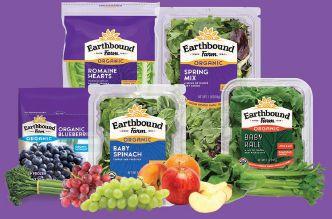
ENJOY WINTER’S HEARTY CHOICES! Our organic kitchen features an all-organic salad bar, daily made soups, mouth-watering sandwiches, as well as smoothies and juices made to order. Beyond the beautiful and delicious selection of fresh organic food, you can stroll through the grounds and enjoy Carmel Valley sunshine in our organic gardens. And, of course, learn about our passion for organic food and farming. Earthbound Farm’s Farm Stand Hours: 9:00 AM - 5:00 PM Everyday 7250 Carmel Valley Road, Carmel, CA (just 3.5 miles east of Highway 1) 831-625-6219 Visit the Farm Stand on Facebook Facebook.com/EBFarmstand






















































































 BY LILY STOICHEFF PHOTOGRAPHY BY MICHELLE MAGDALENA
BY LILY STOICHEFF PHOTOGRAPHY BY MICHELLE MAGDALENA















































 BY ELIZABETH LIMBACH
BY ELIZABETH LIMBACH

















































 BY ROSIE PARKER • PHOTOGRAPHY BY MARGAUX GIBBONS
BY ROSIE PARKER • PHOTOGRAPHY BY MARGAUX GIBBONS









 BY CAMILLA M. MANN
BY CAMILLA M. MANN





































































































































































































 BY PATRICE VECCHIONE PHOTOGRAPHY BY MICHELLE MAGDALENA
BY PATRICE VECCHIONE PHOTOGRAPHY BY MICHELLE MAGDALENA

































 BY JORDAN CHAMPAGNE PHOTOGRAPHY BY MICHELLE MAGDALENA
BY JORDAN CHAMPAGNE PHOTOGRAPHY BY MICHELLE MAGDALENA




























































































































































